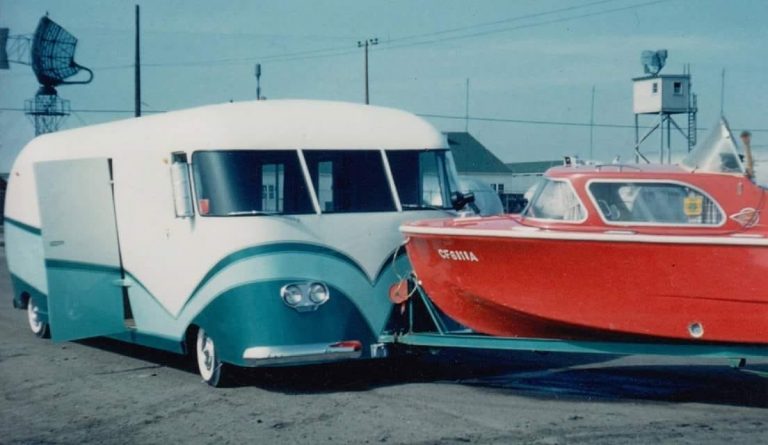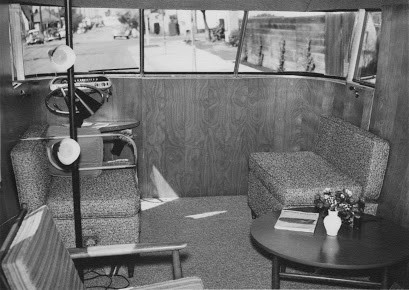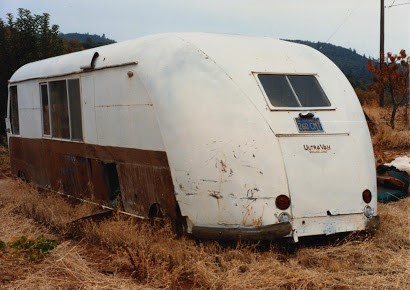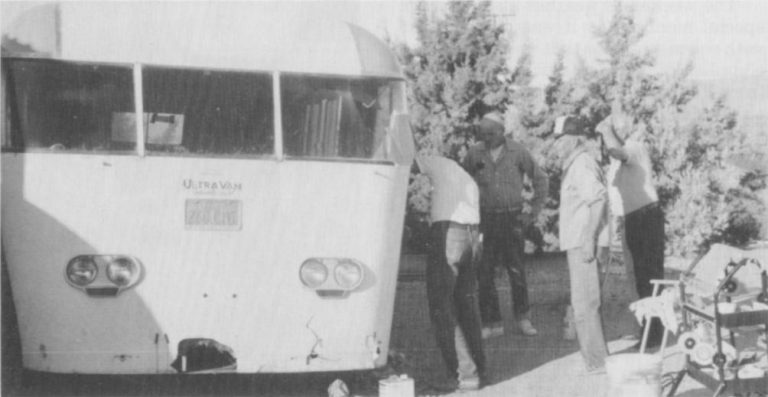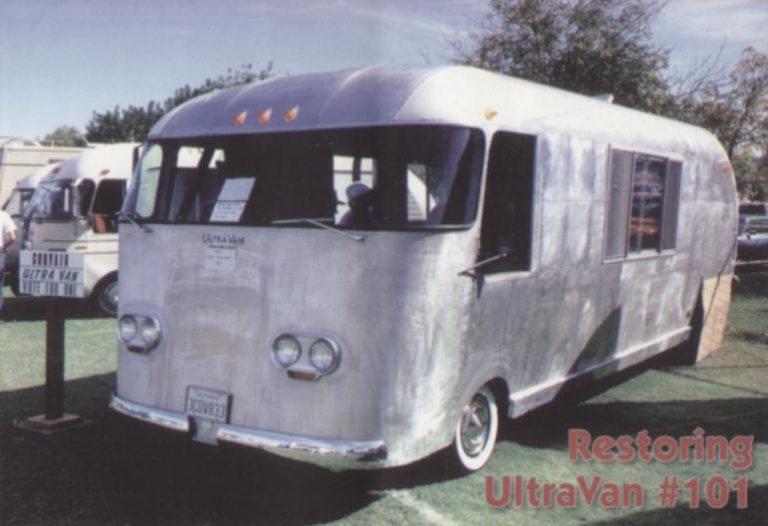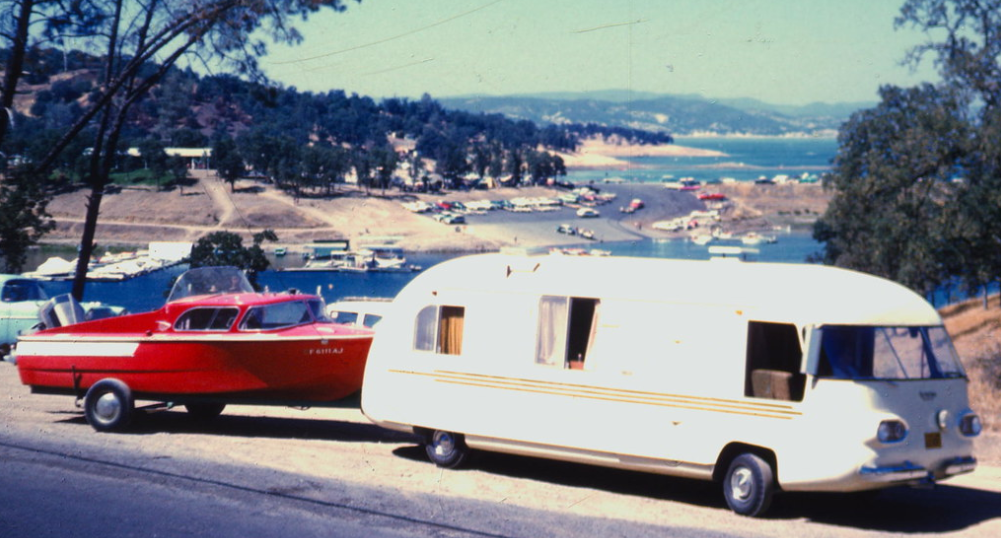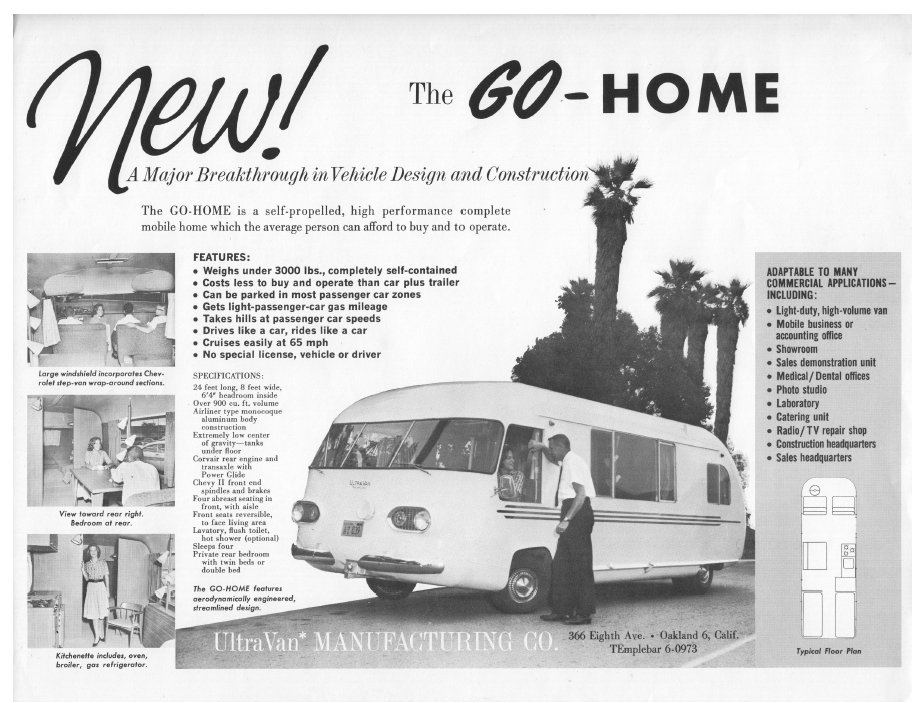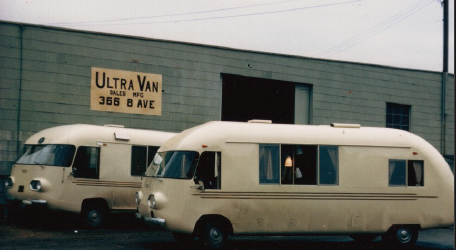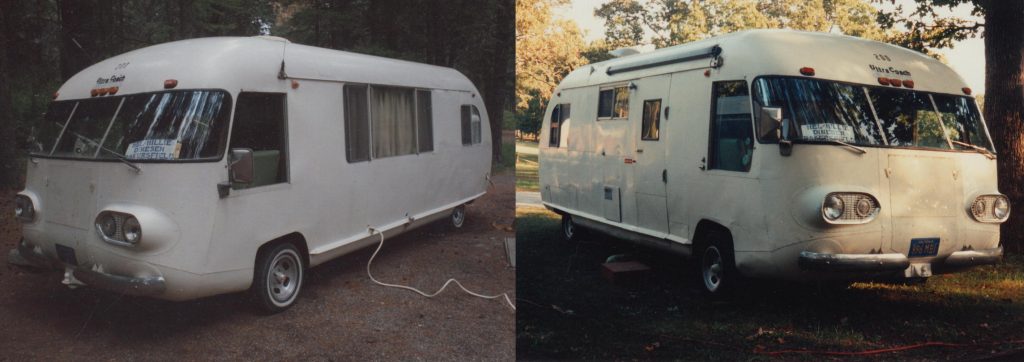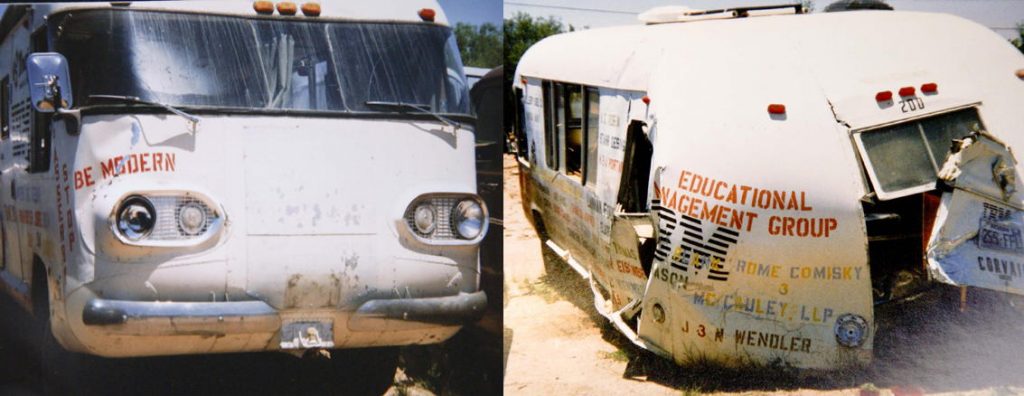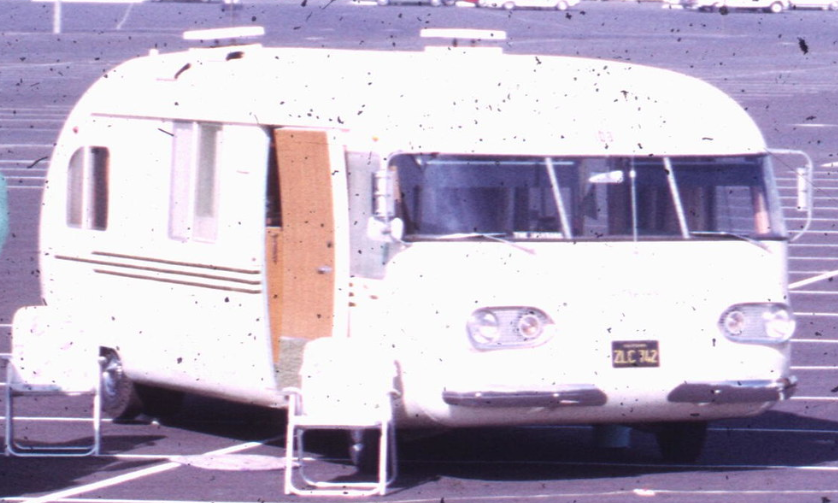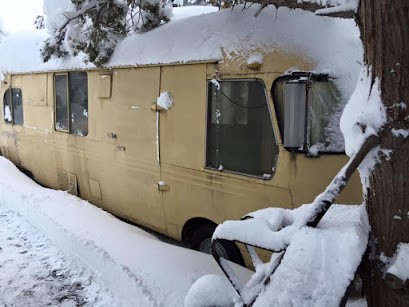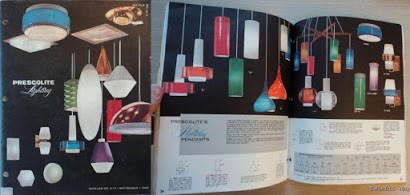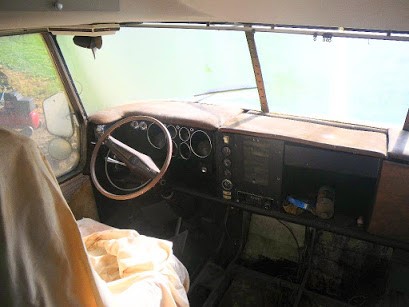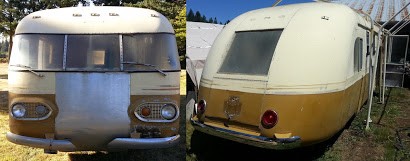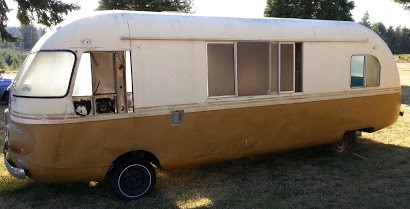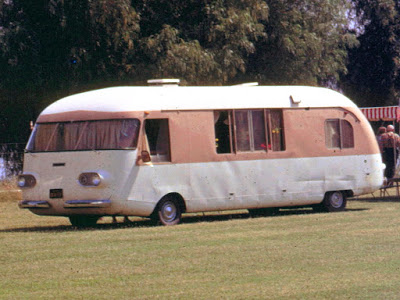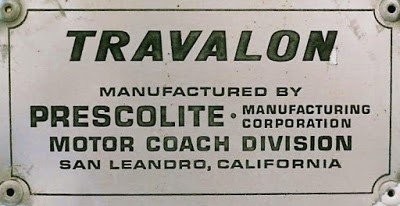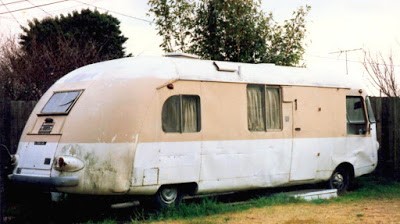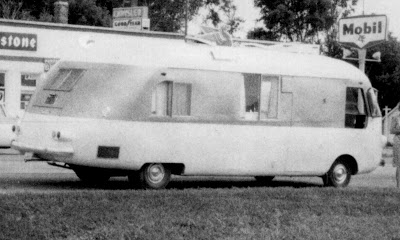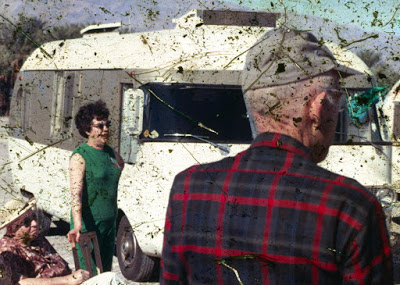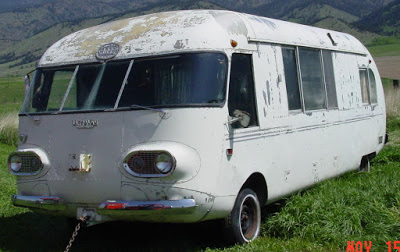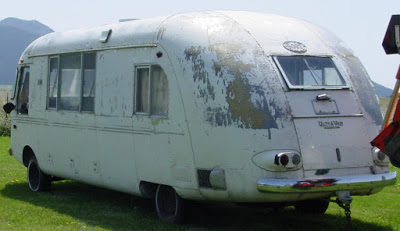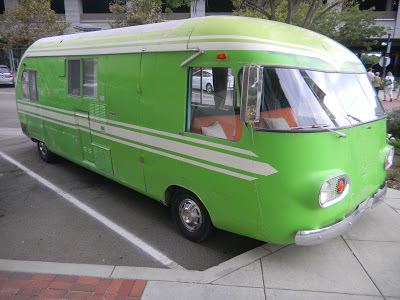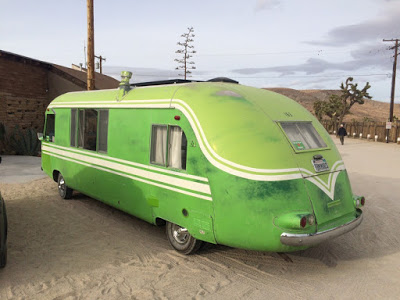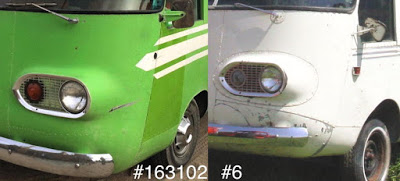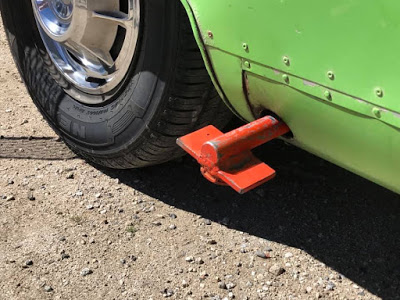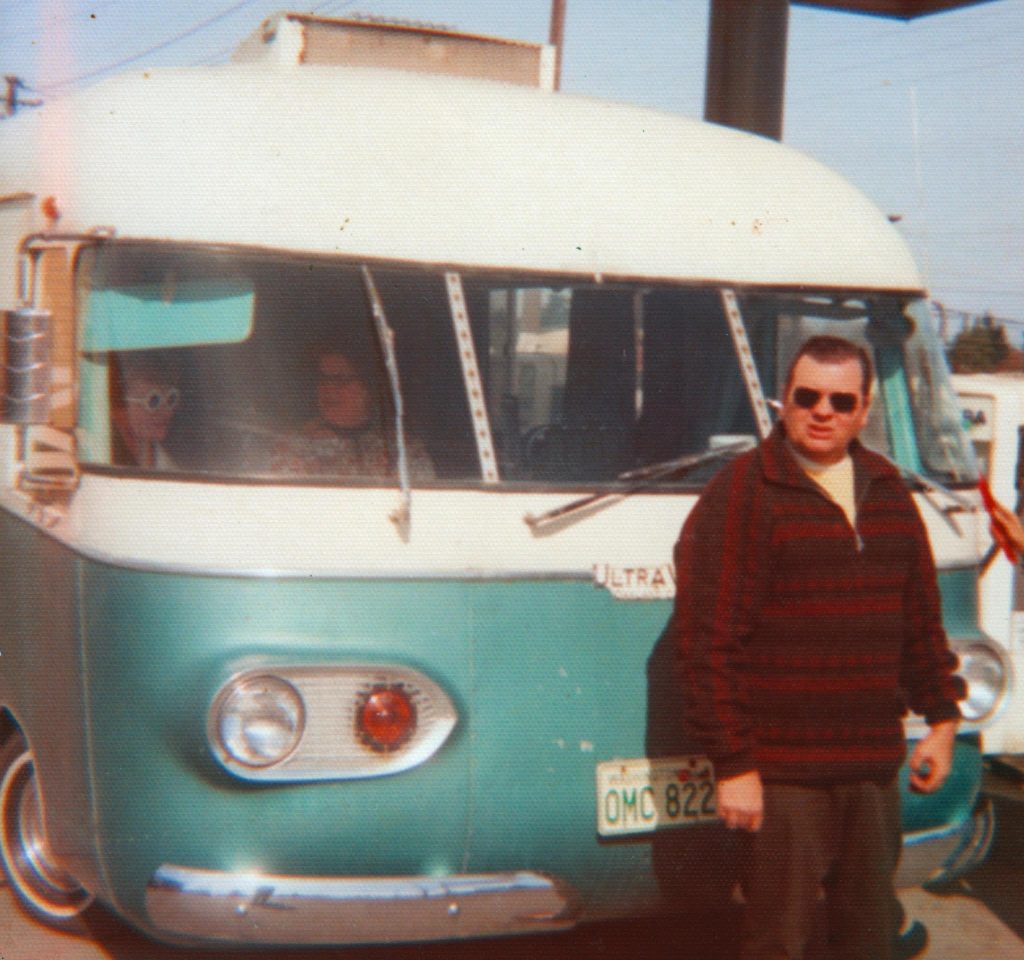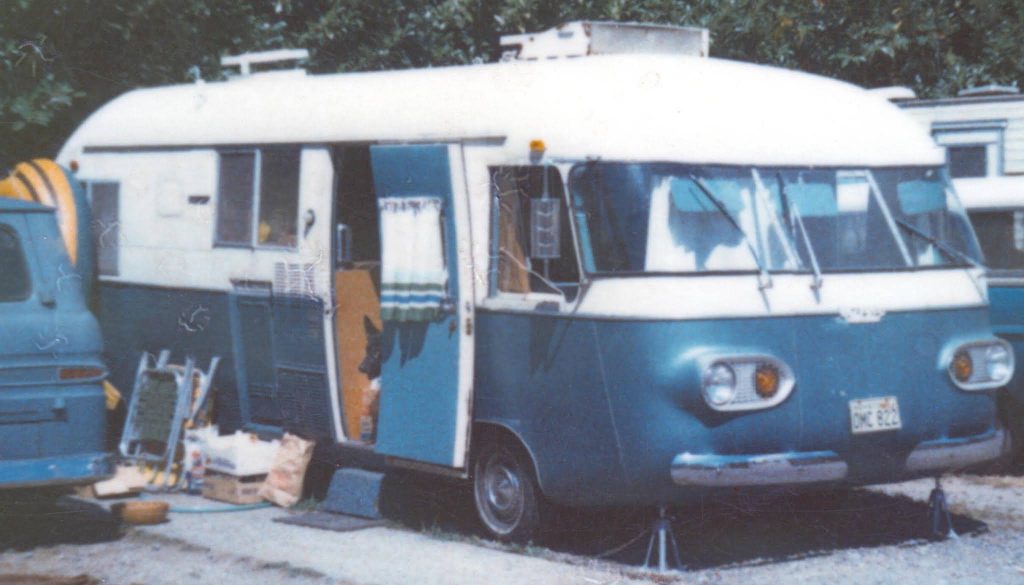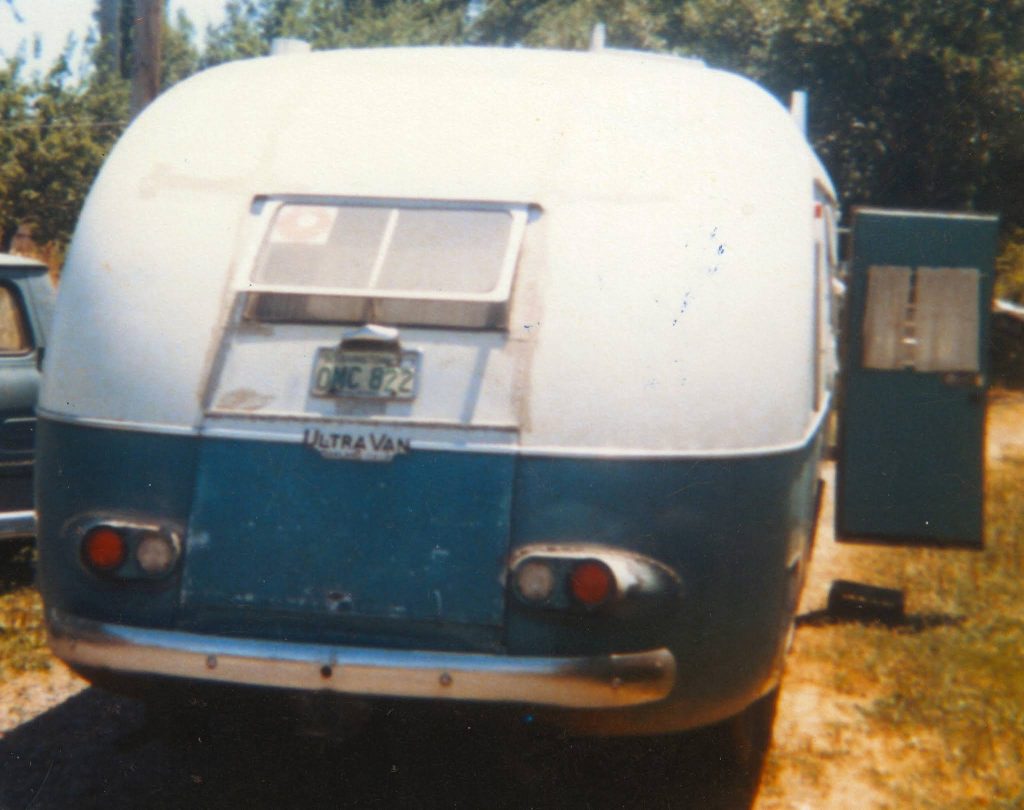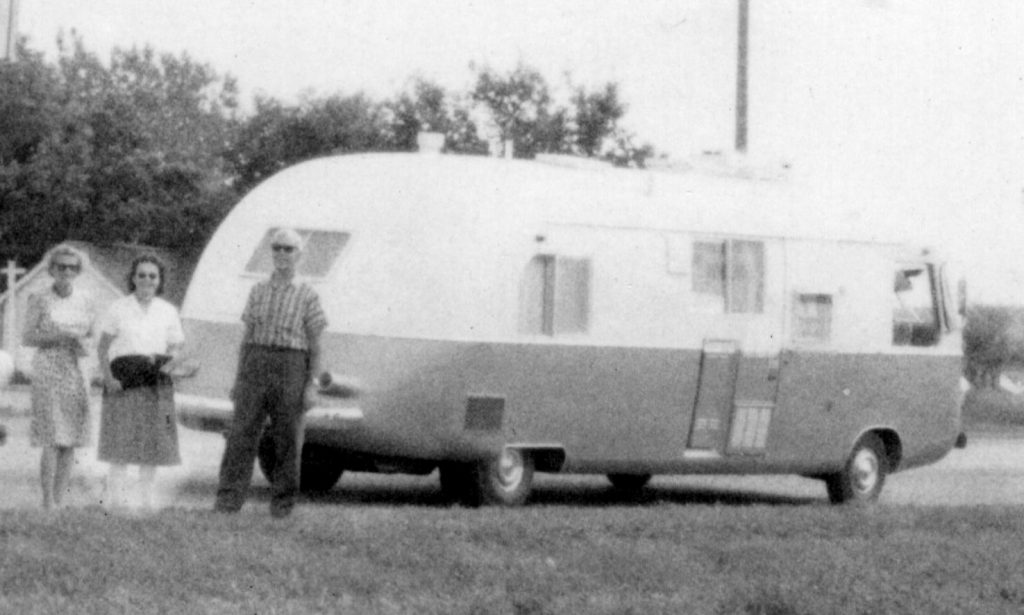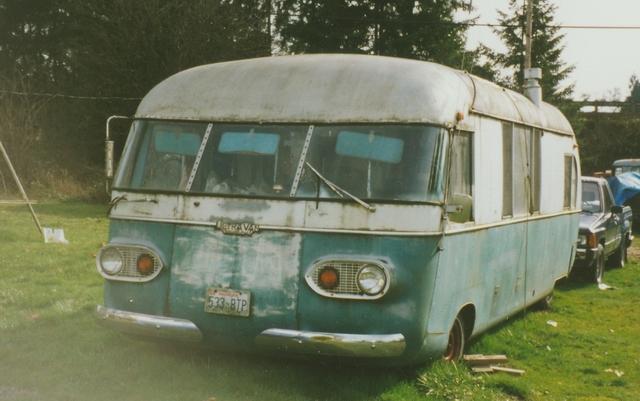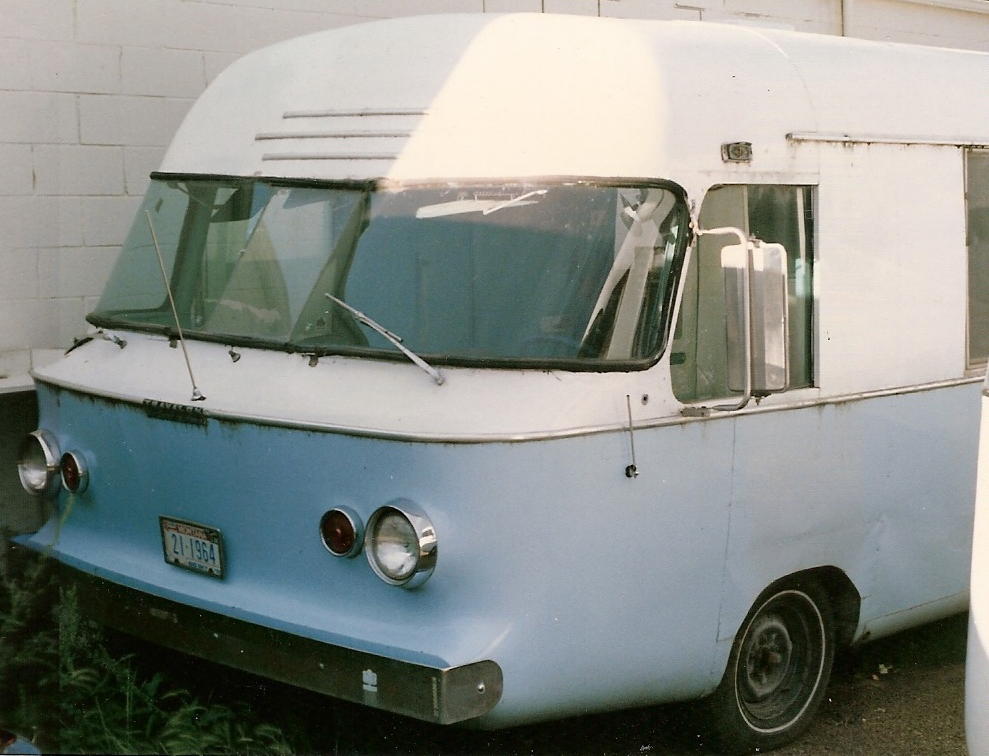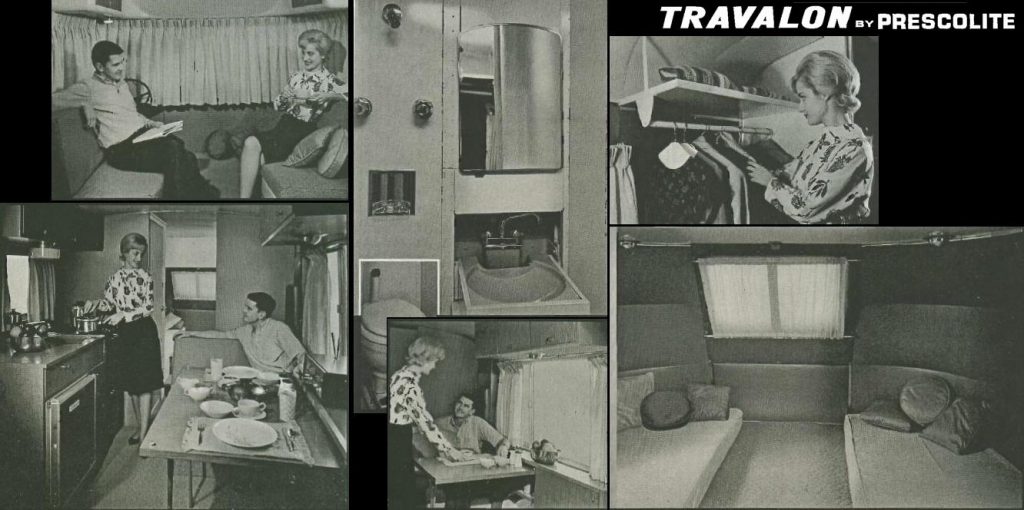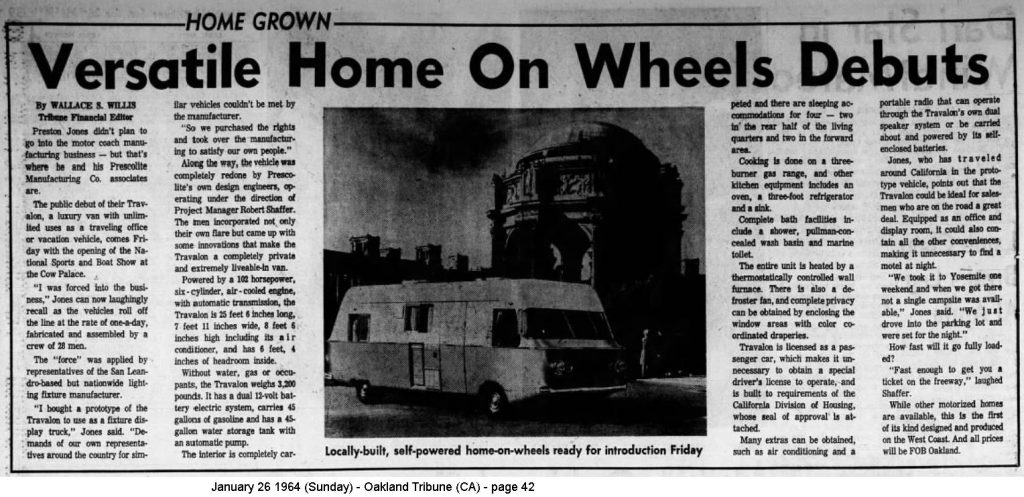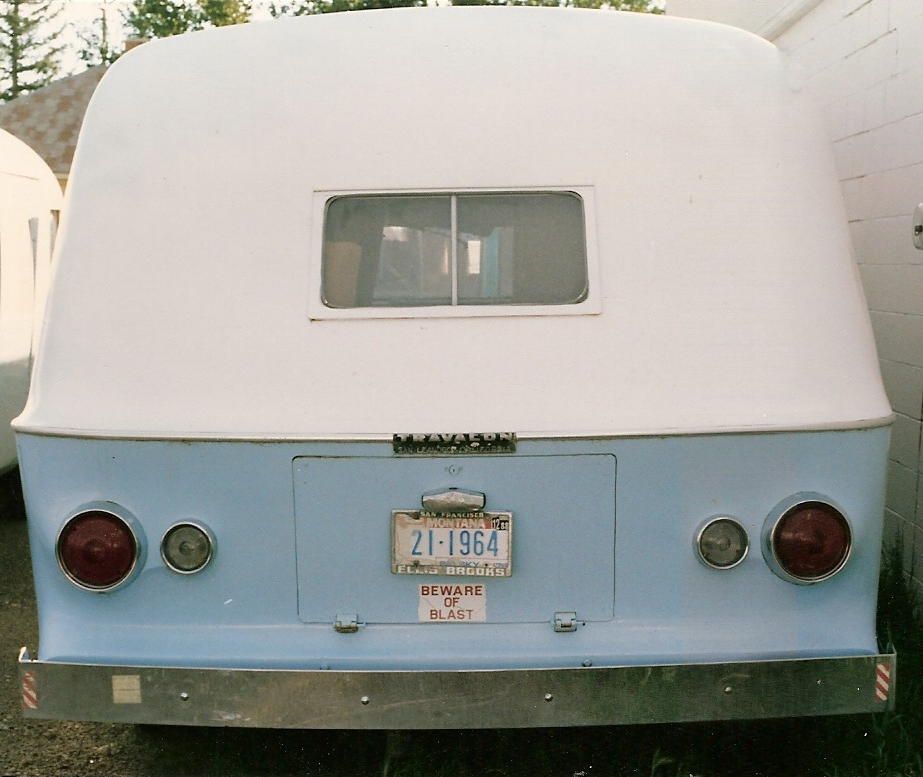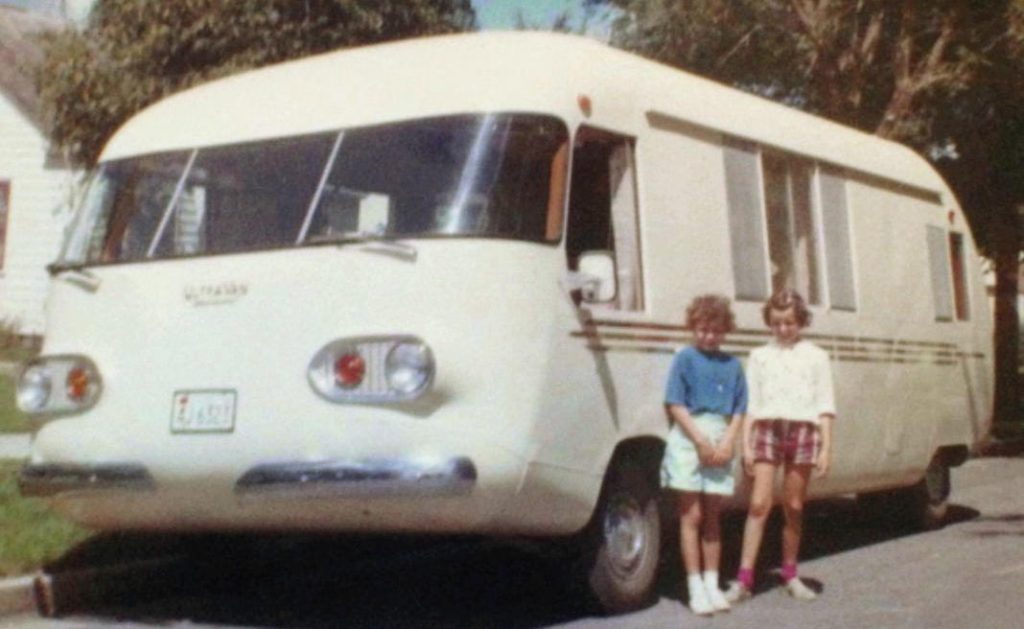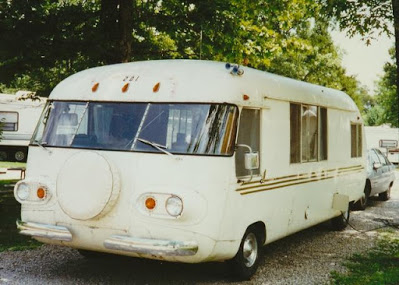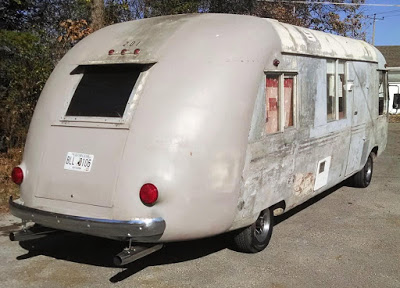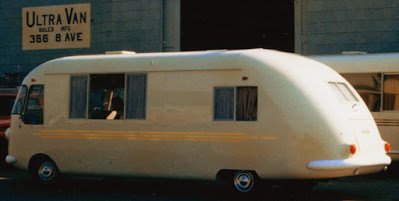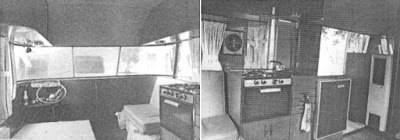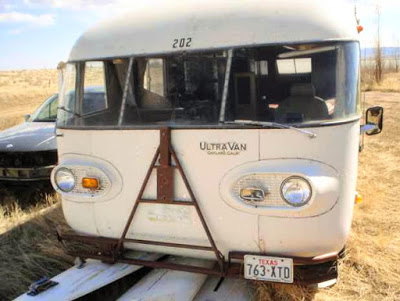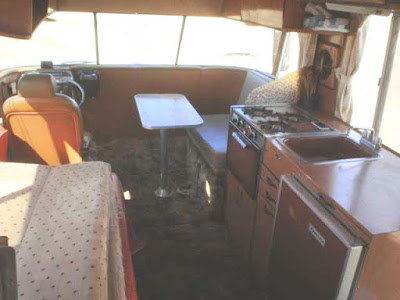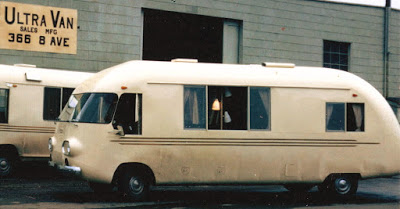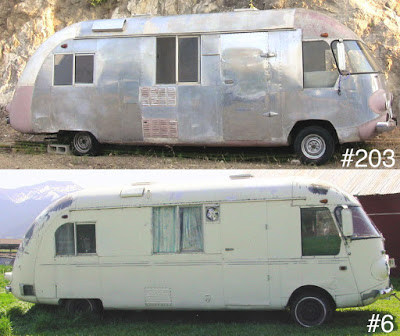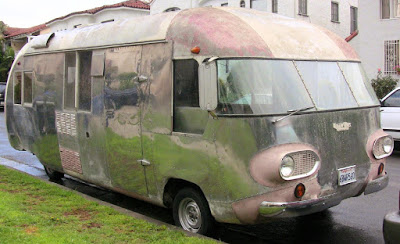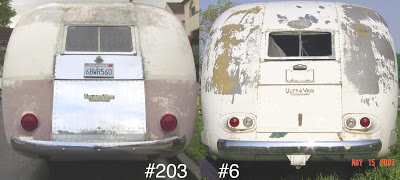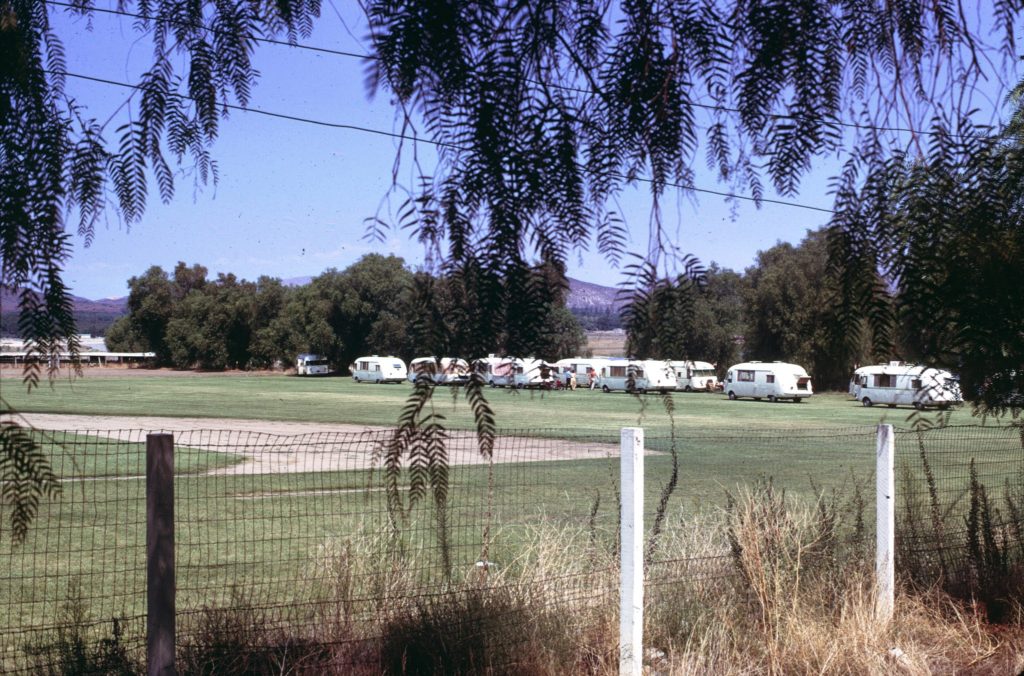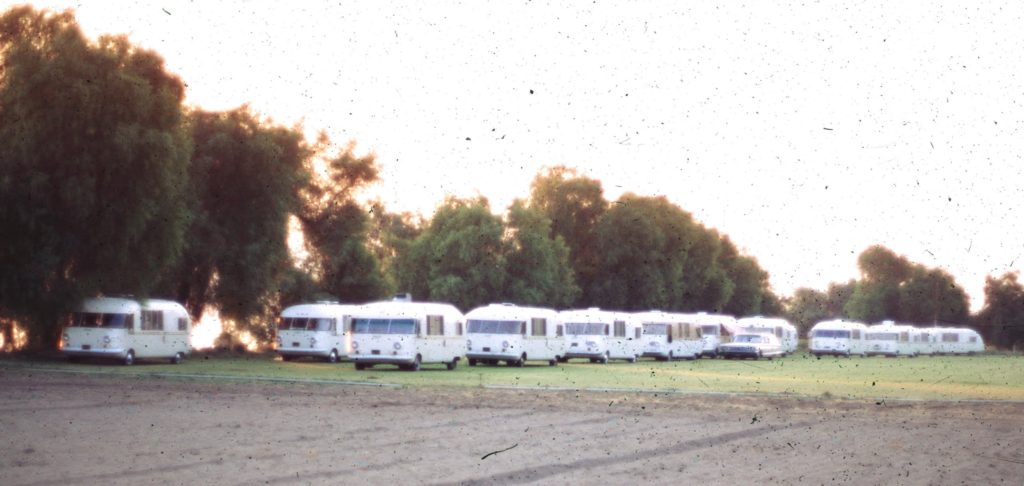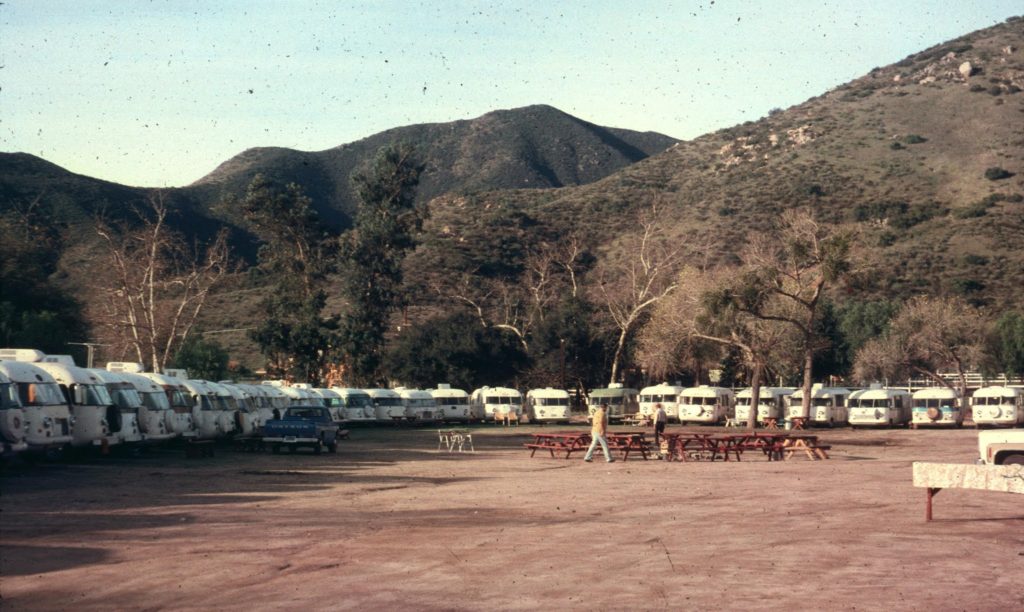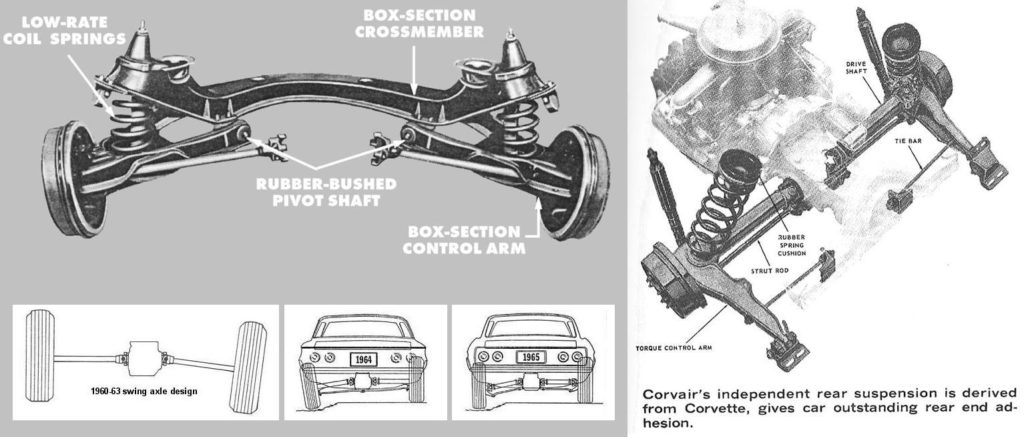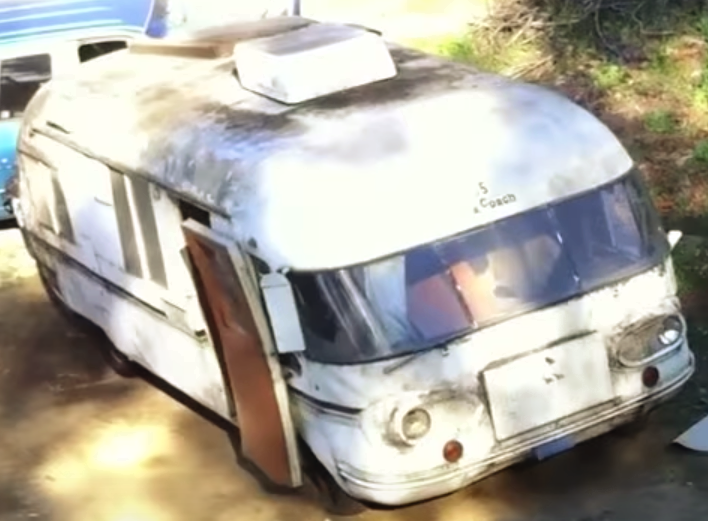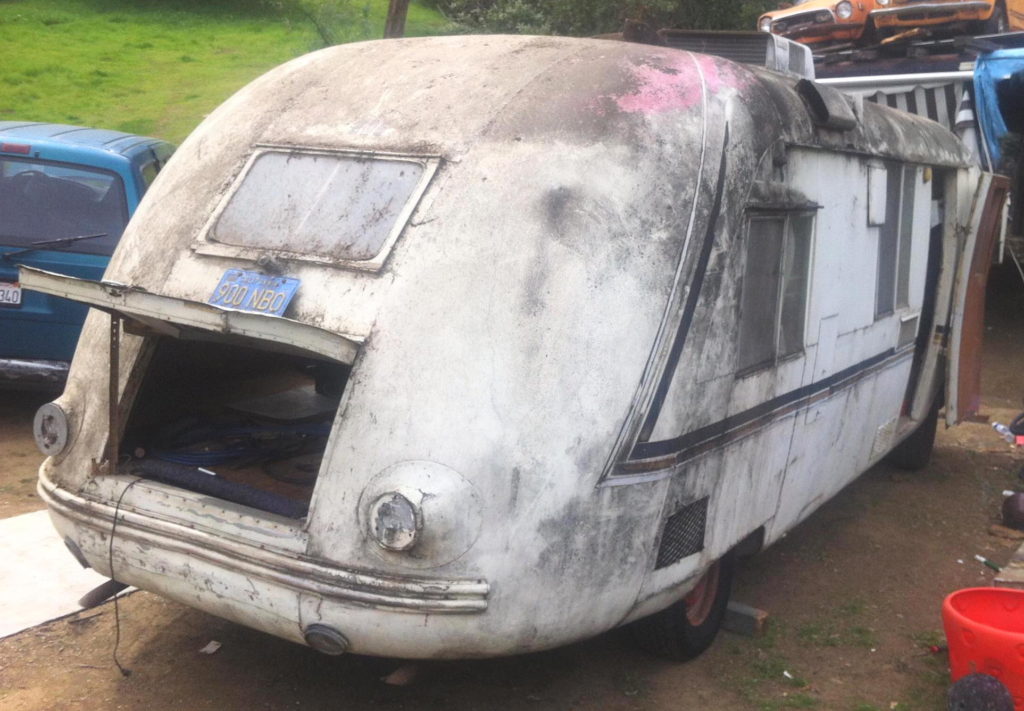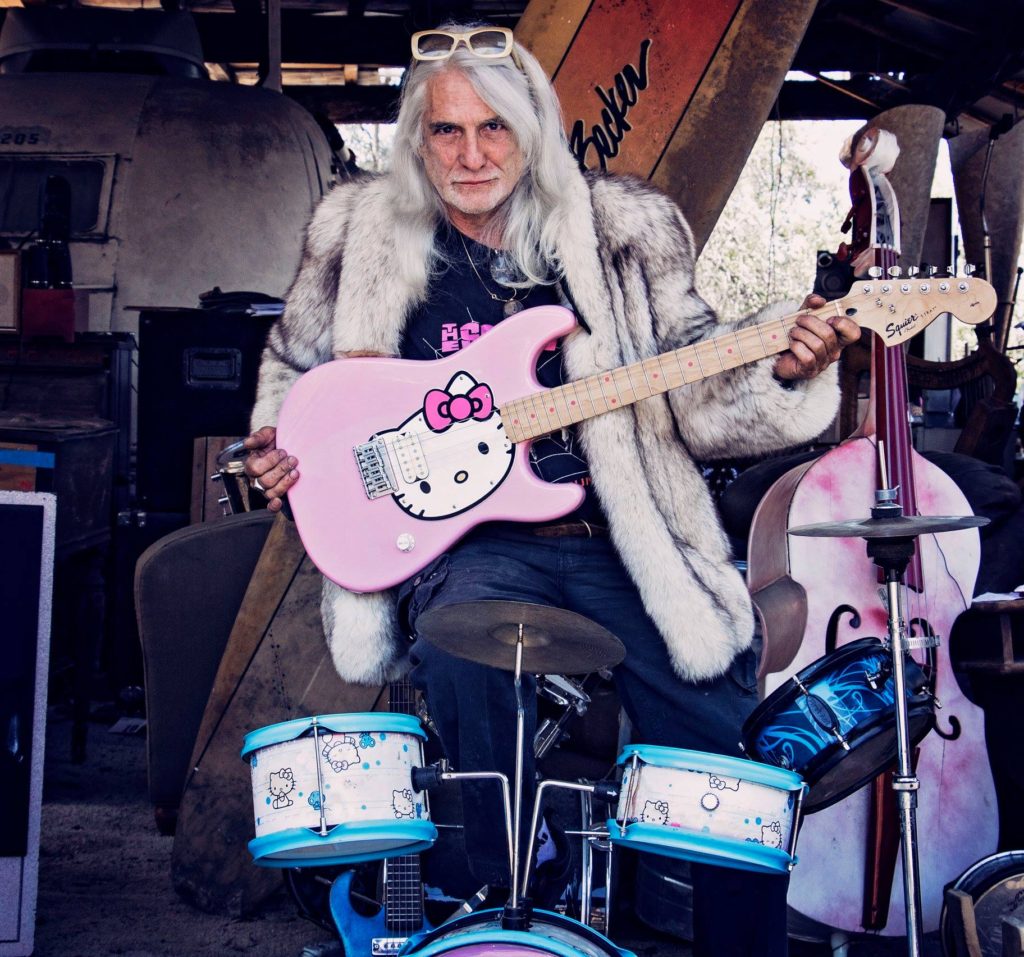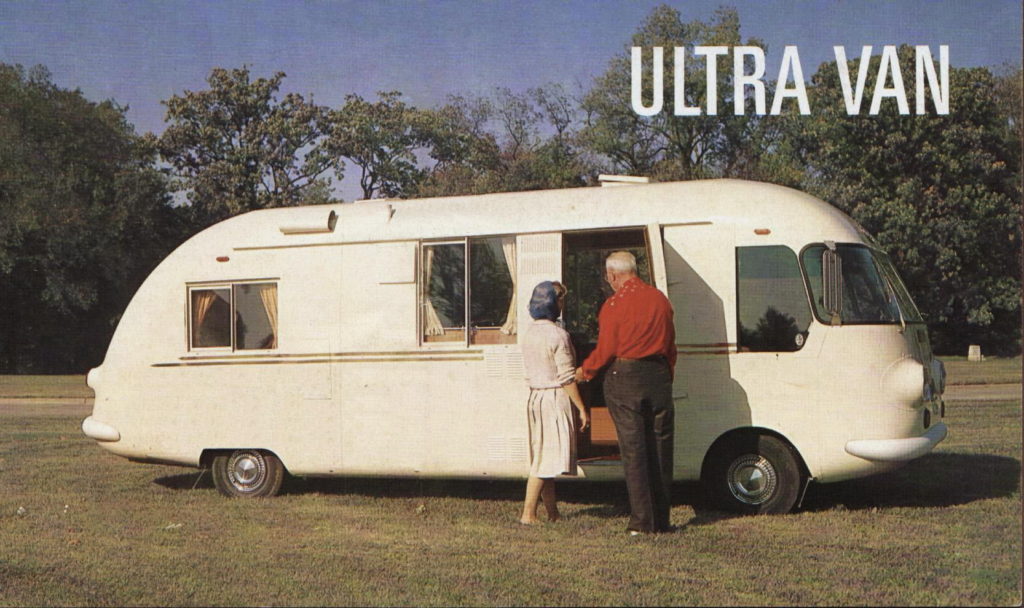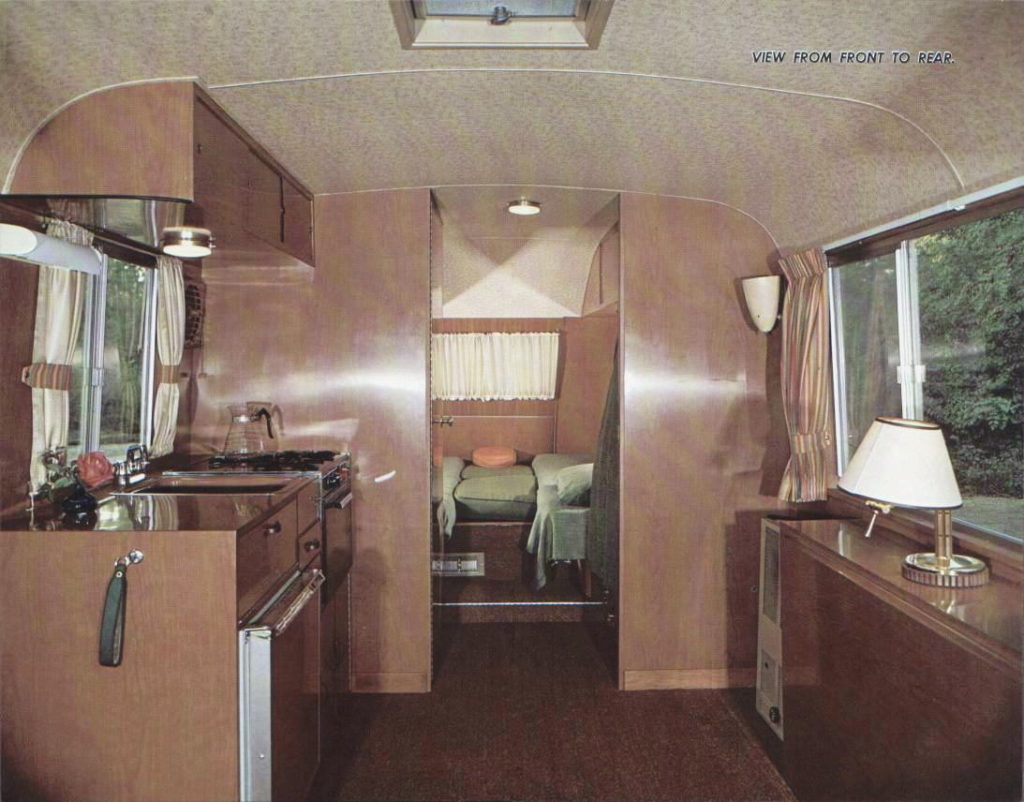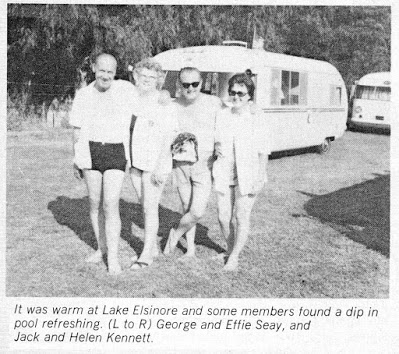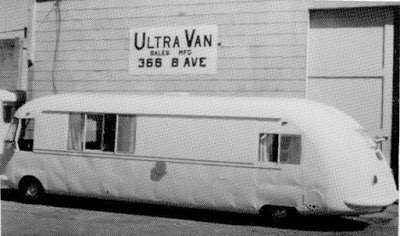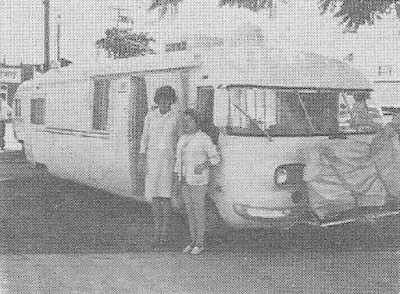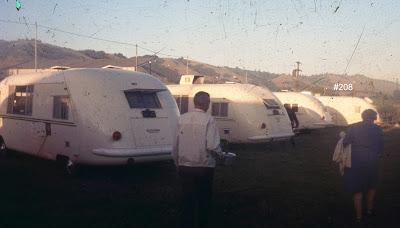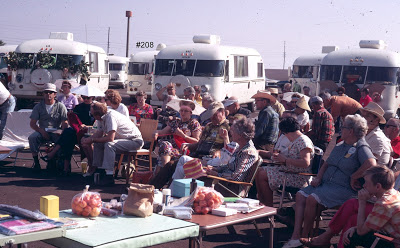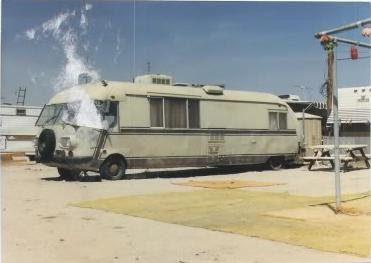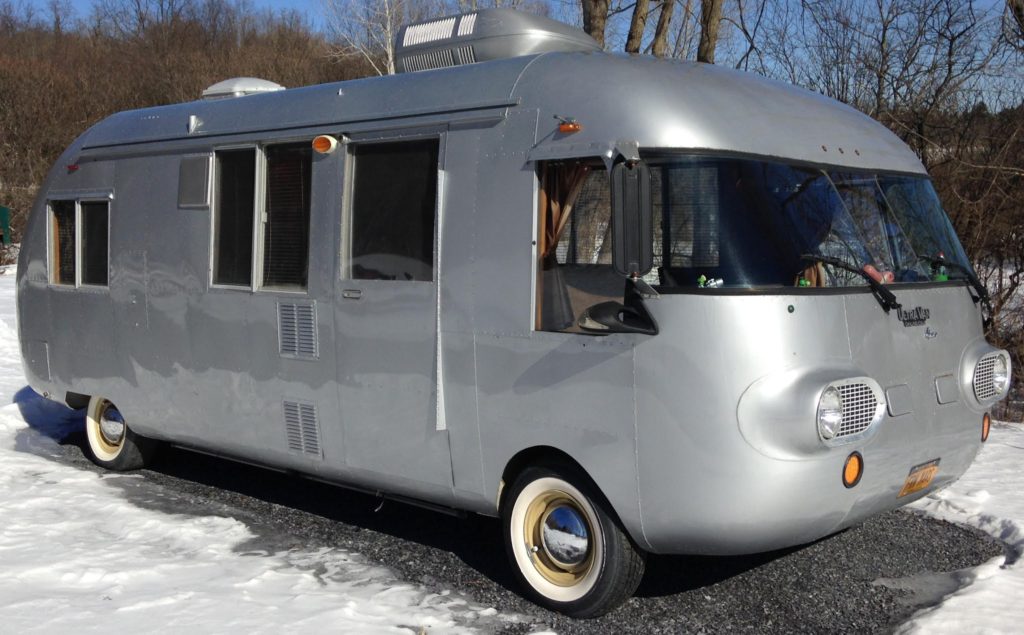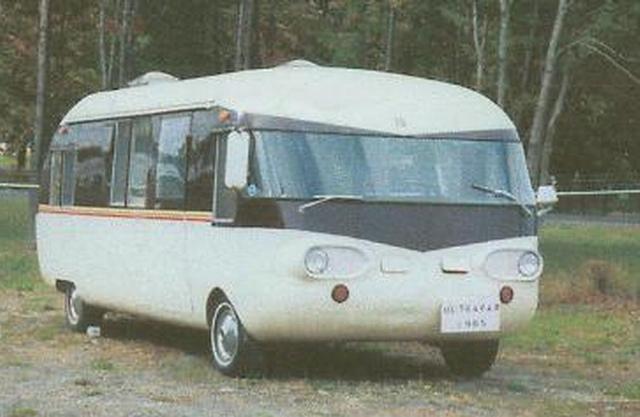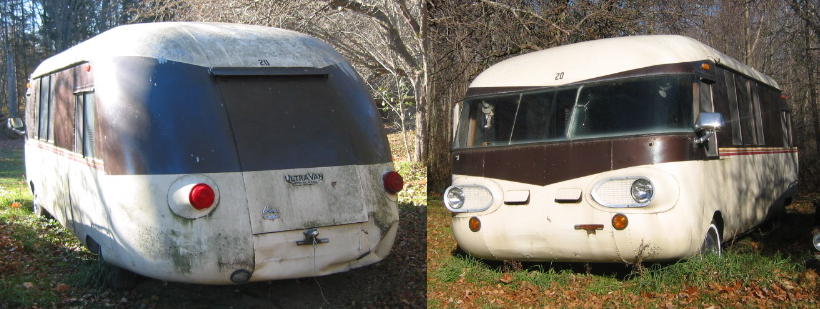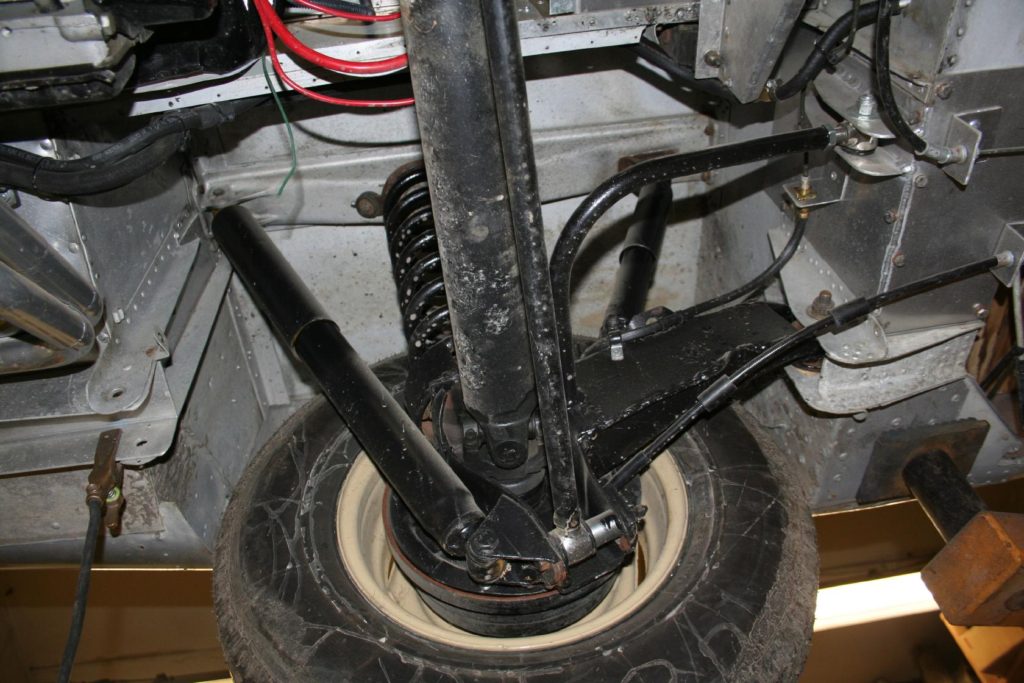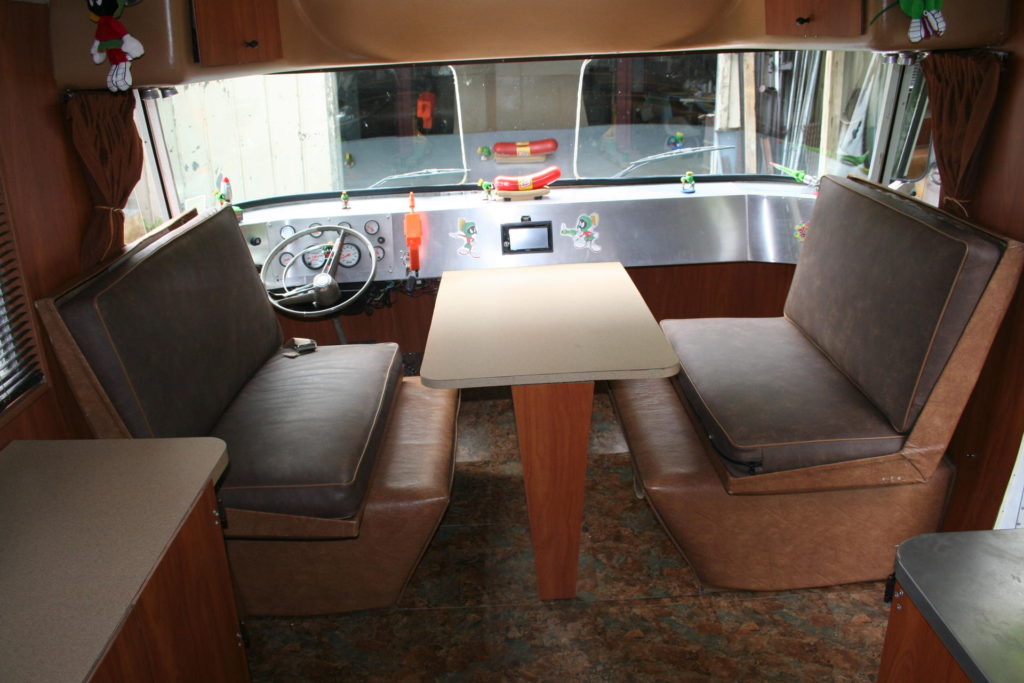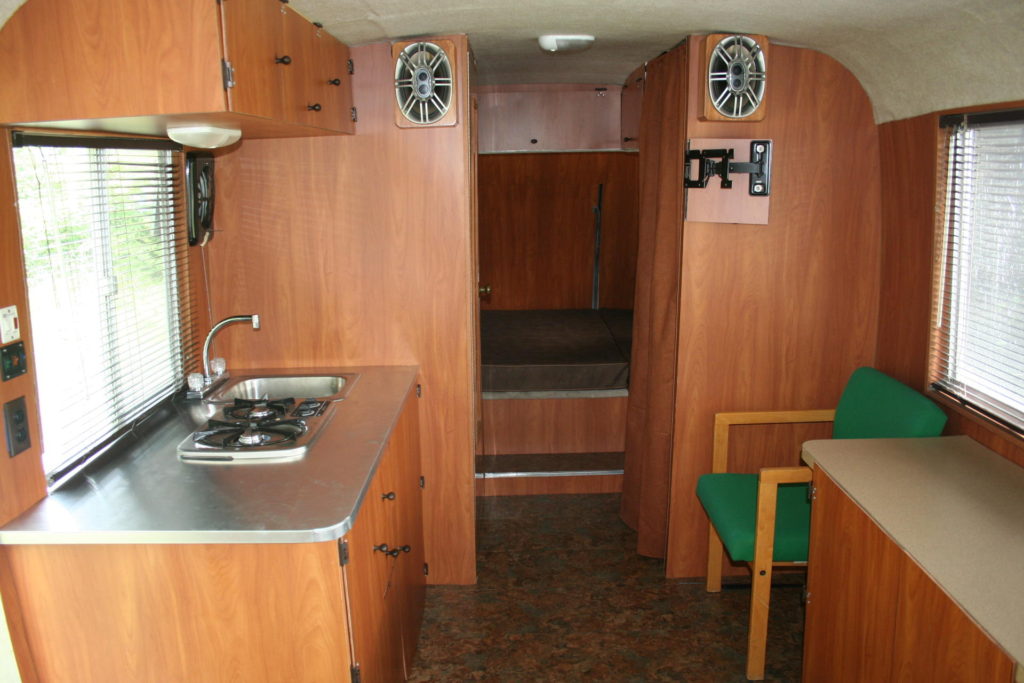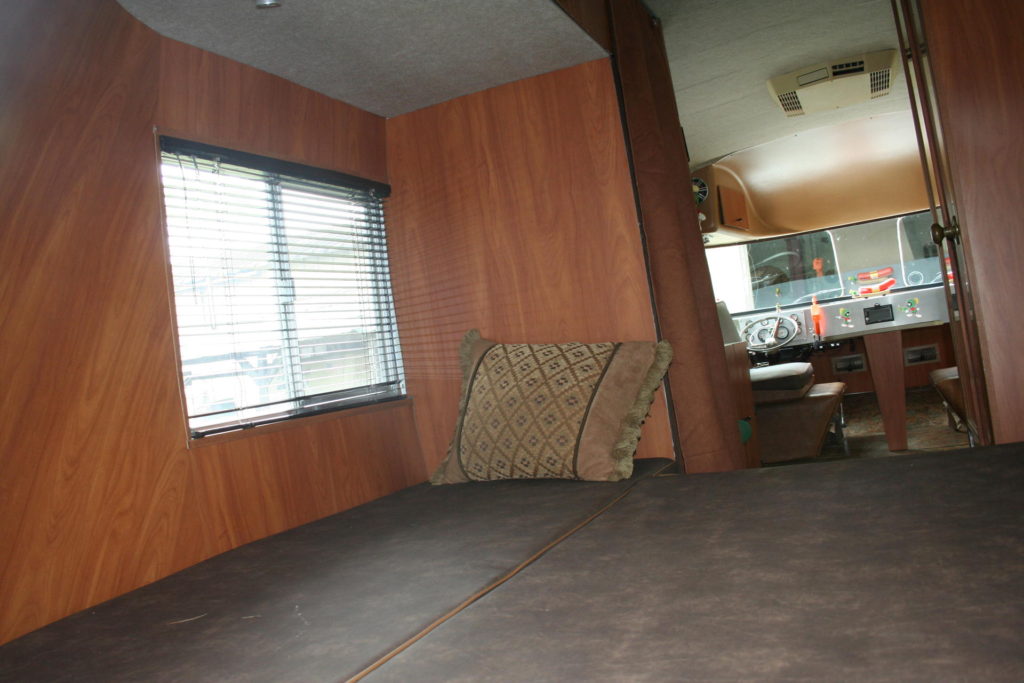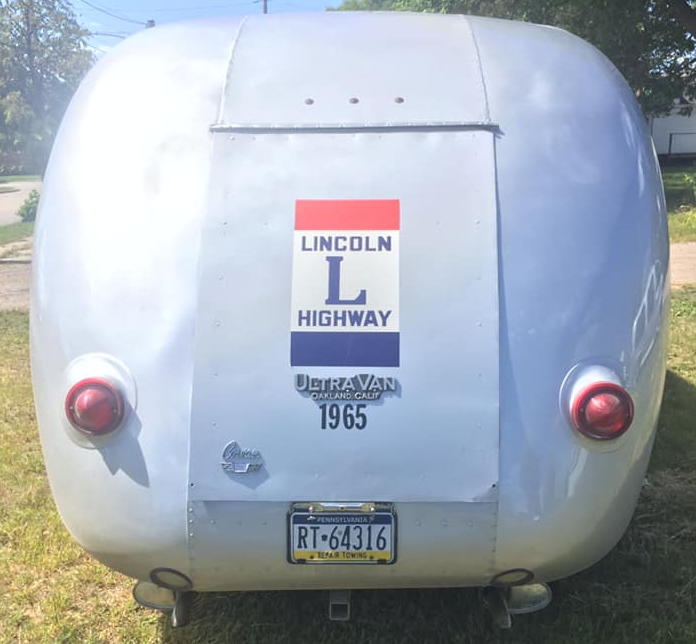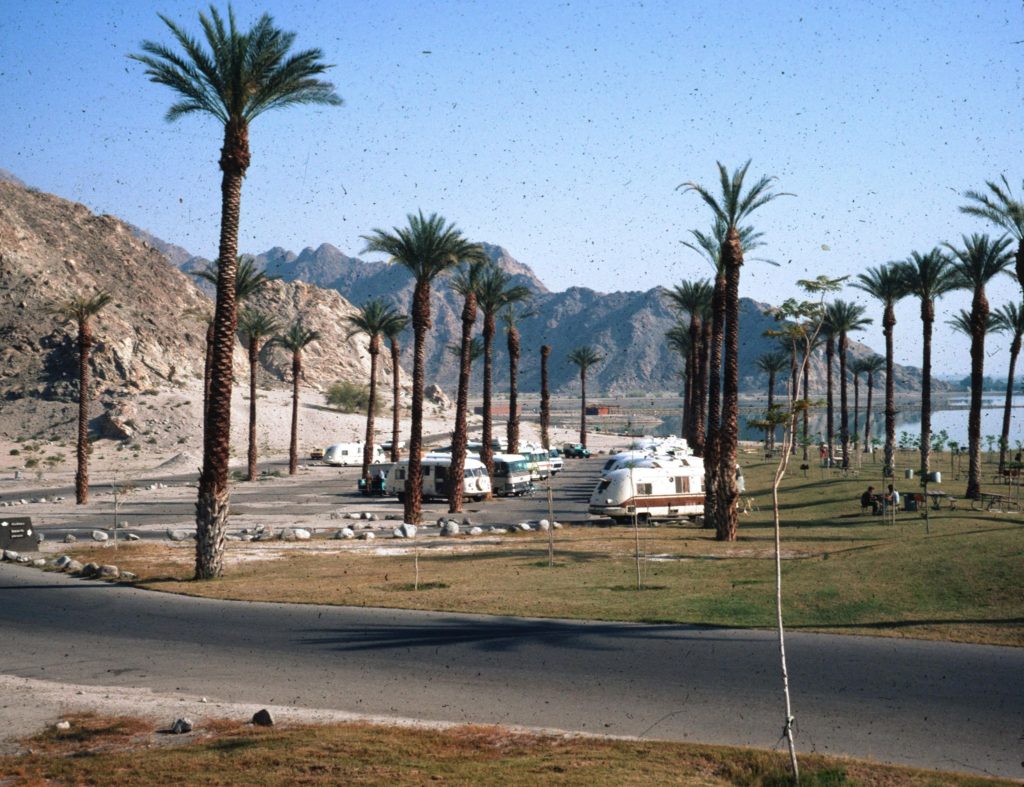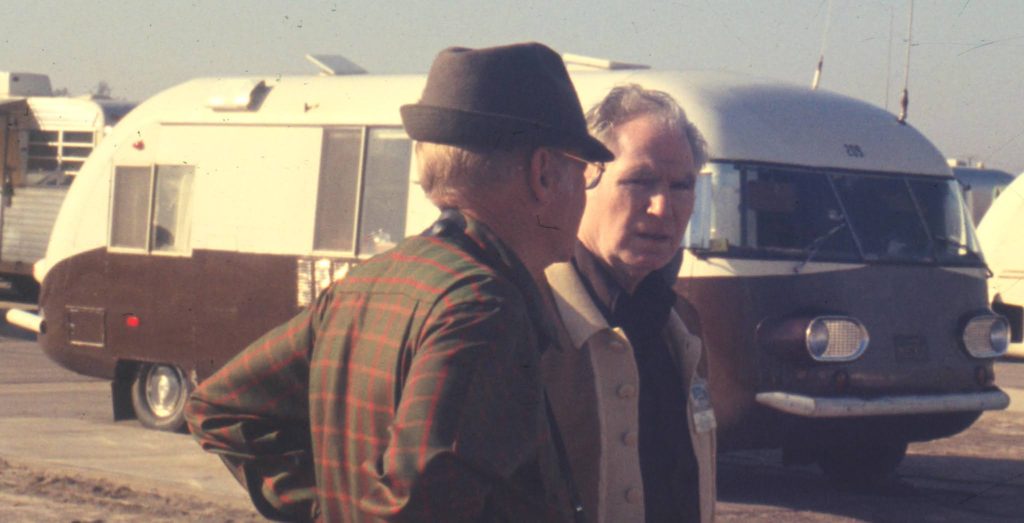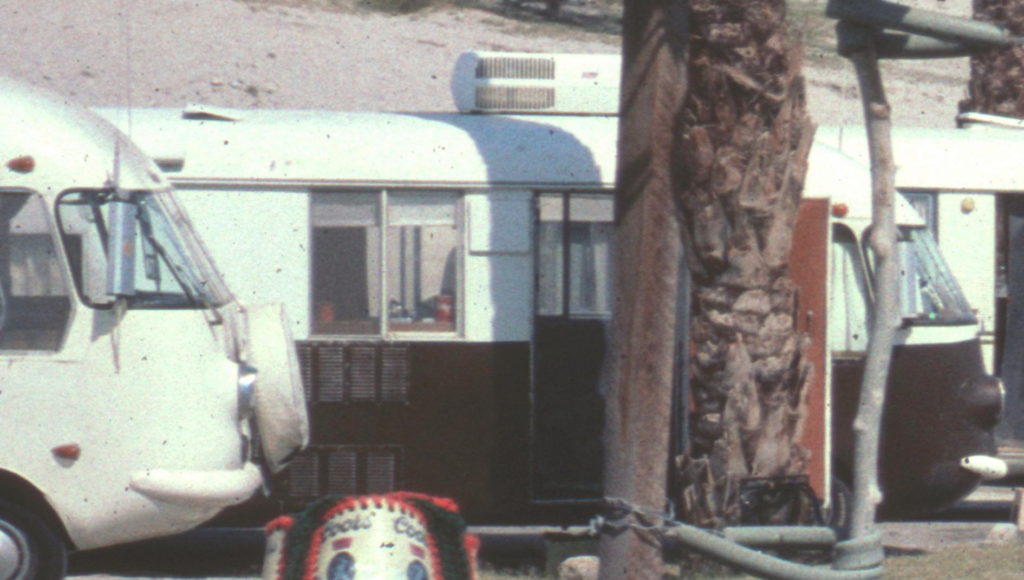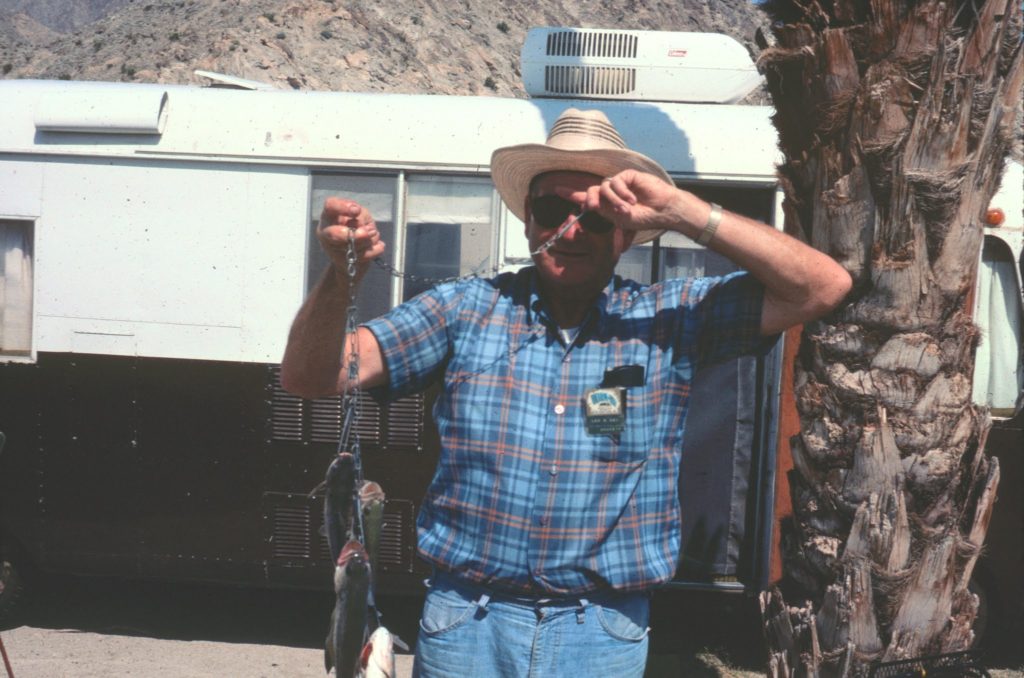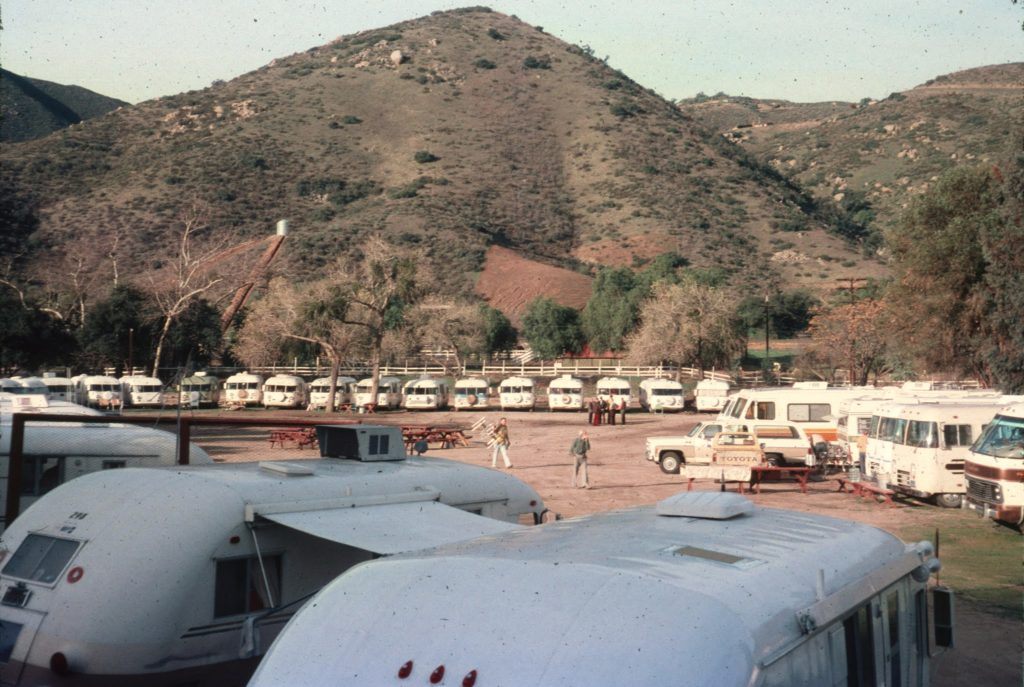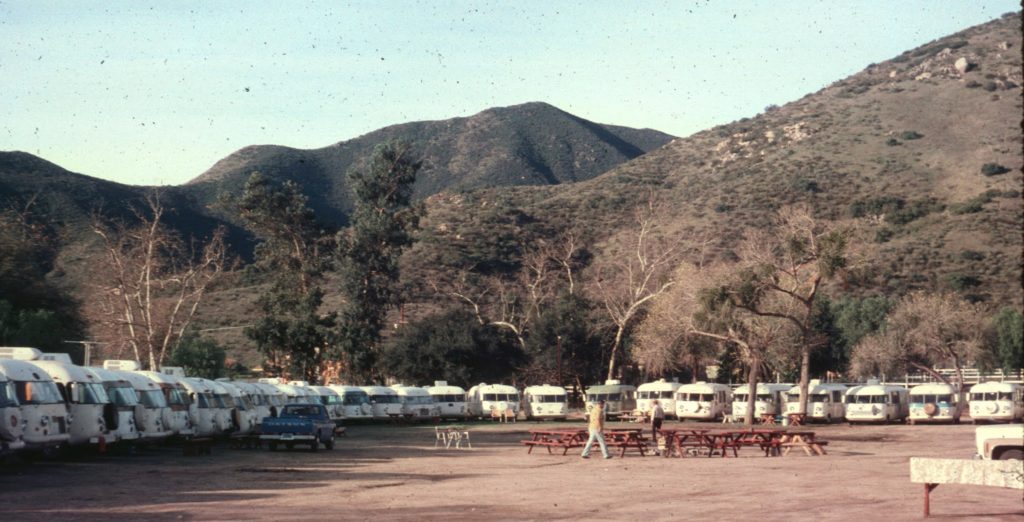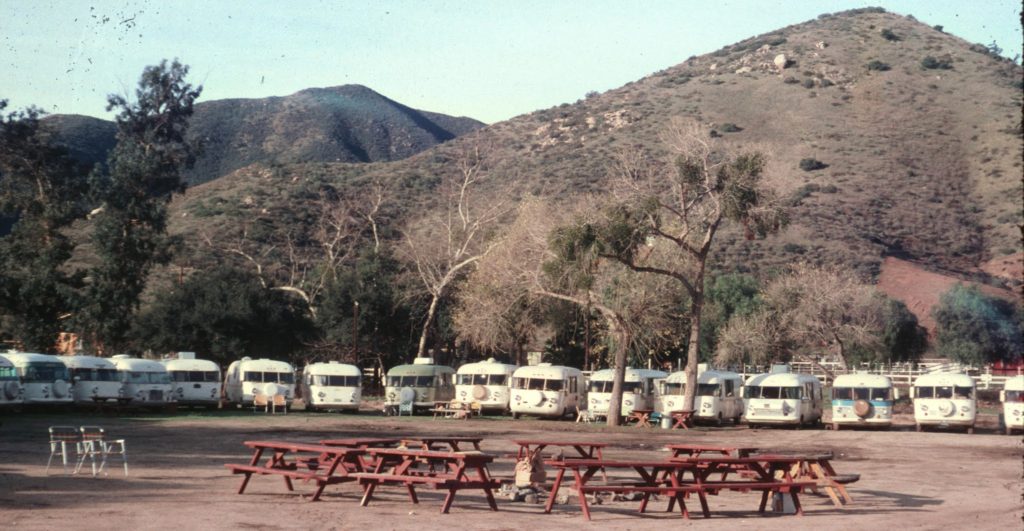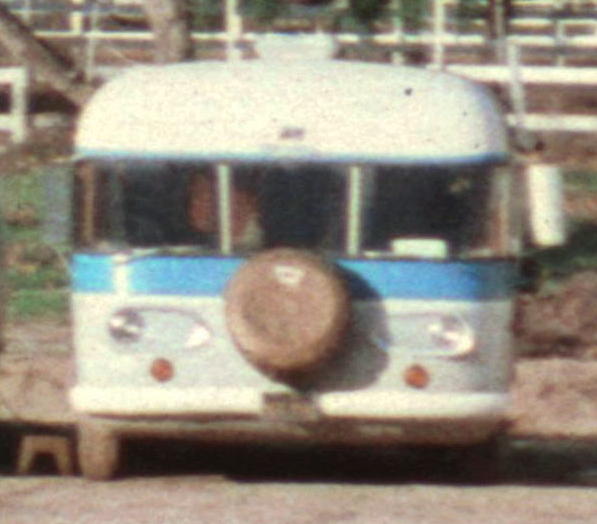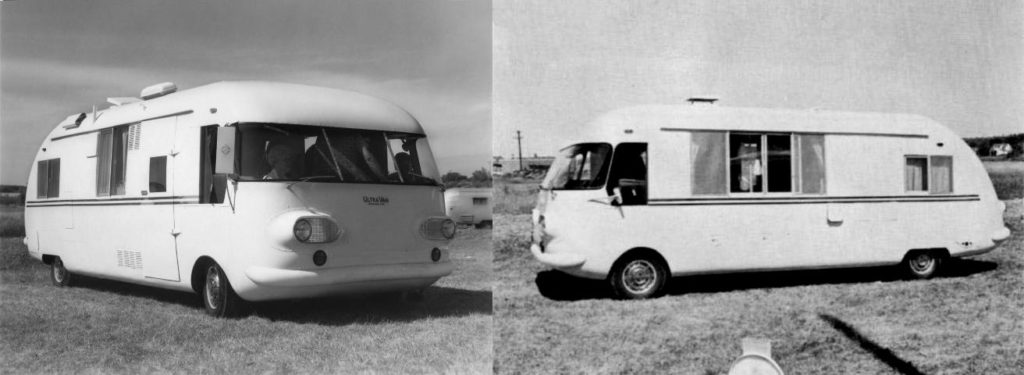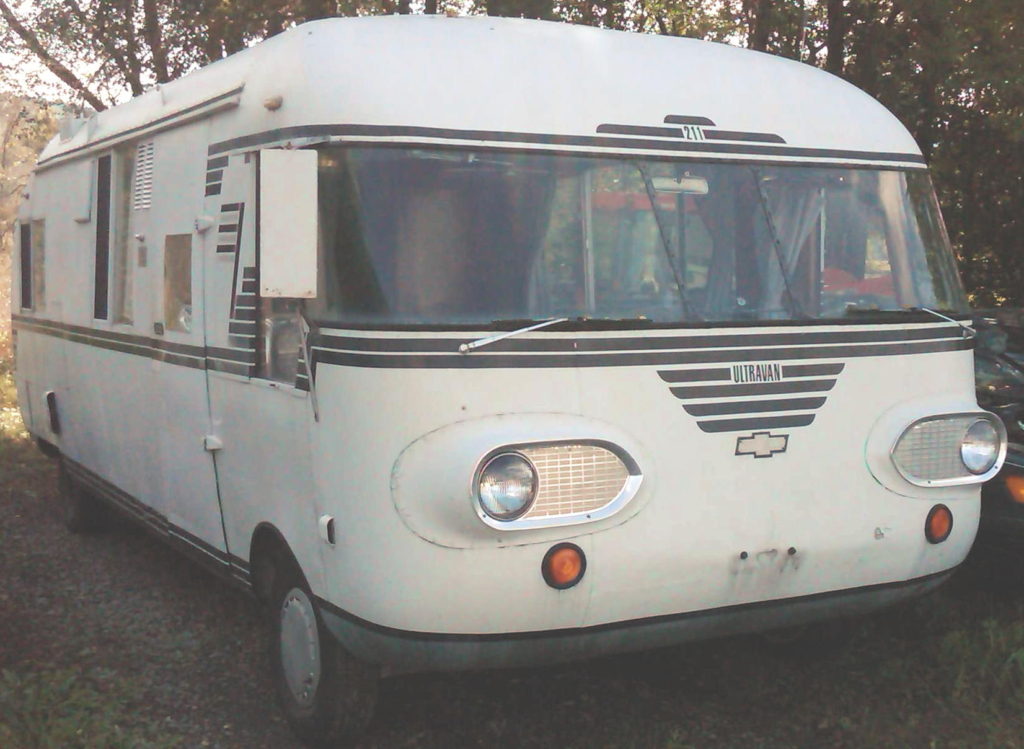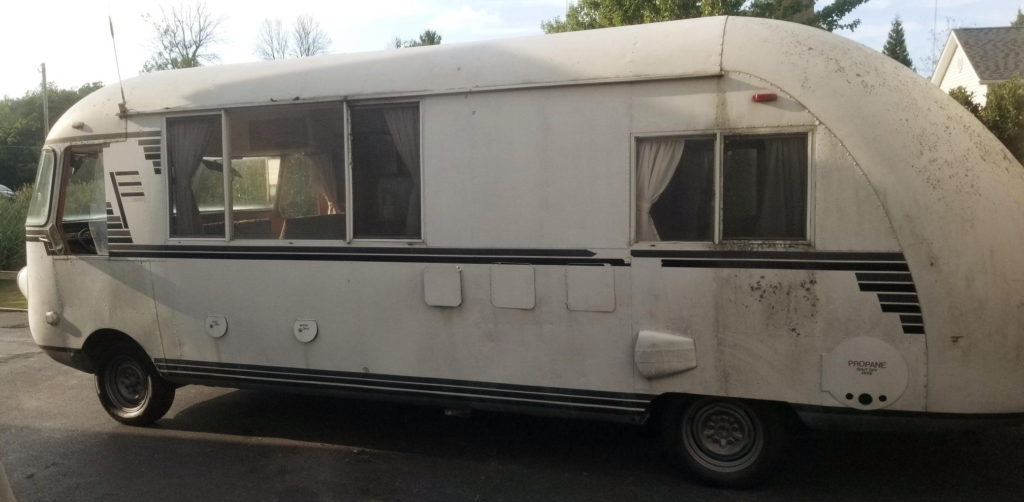The First Ultra Vans
by Historian, Owen Strawn
Dave Peterson’s grandson, Andrew Husmann, states, “I have such great memories of traveling in the Ultra Van…In the family, it was always referred to as “The HouseCar”… That’s how Grandpa always referred to it so we always followed suit. I remember we slept at least 6 in it (maybe 7) at Squaw Valley in the late 70s…Ski in/ski out from the parking lot. Amazing.”
The First Ultra Van
On September 1, 1960, Dave Peterson started construction of the first Ultra Van in a rented garage in Alameda California. Four months later on January 2, 1961, Peterson drove his creation to the Department of Motor Vehicles and received a license for his “1960 housecar”.
The 24-foot-long coach was designed around the remains of a wrecked 1960 Corvair sedan, incorporating the 80-horsepower engine, two speed Powerglide automatic transmission, front and rear suspension, headlights, taillights, and instrument panel. The windshields were sourced from a Chevrolet stepvan, the bumpers from a ’47-55 Chevy 3100 pickup, and most everything else was hand built from riveted aluminum and fiberglass by Peterson himself.
For maximum living space, the coach was a full 8 feet (96 inches) wide at the top. To work with the suspension from the 67-inch-wide car Peterson developed a unique reverse-tumblehome body shape that narrowed the body to just 86 inches at the bottom. Then he cut out the car’s front suspension crossmember, moved the two remaining assemblies apart, and riveted them to the coach structure. In the rear he added ornamental dually rear wheels to fill out the wheel wells. To insure the dually wheels wouldn’t overload the car’s suspension he kept them at a very low air pressure.
The rear body was shaped to resemble Peterson’s beloved Spartan travel trailer. Remarkably, both fiberglass rear corner panels were created using the same mold, but one of the panels was flipped inside out when the resin was partially cured. Two tow hitches were installed – one on the rear to tow his 1958 Dorsett Catalina, and a second on the front to launch and recover the boat.
Without any interior furnishings the revolutionary coach weighed less than 1,800 lbs. empty – “Five times the cube of the VW Van and 400 lbs. lighter”, or “one-half the weight of a Greenbrier and over twice the space.” Even after the finished interior was installed it still weighed under 3,000 lbs.
Peterson (David G.) and his son (David L.) operated the coach until at least 1973, at some point modifying the side windows to more closely resemble the production Ultra Vans. Then for one and a half dozen years the coach passed out of all knowledge into history and legend. Eventually rumors of an unusual Ultra Van came to Jim Craig via his friend Mory Snyder, and together they tracked down the prototype rotting away in a grape field near Oroville, California.
Recovery was accomplished by April 1990, and a Club restoration project was organized with many donations of time, labor, parts, and even cash. By 2001 interest had waned; only one couple showed up to the final Restoration Rally. In 2003 the coach found a new home at the Lane Motor Museum in Nashville Tennessee (profits from the sale were returned to the Club). Lane displayed the coach until early 2014, when it was purchased by Craig & Lea Lamond and driven to Portland Oregon. The Lamonds plan to return the prototype Ultra Van to its original configuration.
The Second Ultra Van
Although Dave Peterson built the first Ultra Van for his own personal use, he received so much attention and interest whenever he took it out that very soon he started working towards production. By late August 1961 he was showing renderings of a proposed “Conestoga Motorized Home” to potential investors in “The Ultra Van Manufacturing Company”. The new concept was much modified, perhaps addressing lessons learned in the construction and early use of the prototype.
He set up shop in a wooden warehouse at 366 8th Avenue in Oakland (which he would continue to use through 1973), tacked up a full scale profile of the coach on the wall, hired some local high school & tech school students, and started building “the Demo Van” (which would later be known as Ultra Van #200).
Surviving records show that on October 3 1962 Peterson demonstrated his “Go-Home” to Ed Cole at the GM engineering center in Detroit; in mid-November 1962 the Go-Home flyer (featuring a photo of the completed Demo Van) went to press in the 1963 Chevrolet Silver Book; on February 1-10 1963 the coach itself was displayed to the public at the 19th annual San Francisco National Sports and Boat Show (at the Cow Palace); and on March 30-31 1963 it was displayed at Montgomery Chevrolet in North Hollywood. The coach was last registered as a 1963 model.
The new design carried over the prototype’s 24 foot length, Corvair drivetrain & swing-arm rear suspension, stepvan windshields, Chevy 3100 pickup bumpers, front and rear tow hitches, ornamental dually wheels, and Spartan trailer rear body shape; however the reverse-tumblehome side profile was abandoned in favor of a more conventional shape.
The new coach sported Ford Econoline headlights, Ford Falcon taillights, and a new full-width front suspension incorporating very large control arms. Unique features of #200 include the shape of the front wheel arches and the wedge-shaped rocker panel trim. The left side molding was actually used as an external wiring harness gangway. Peterson reported that the completed Demo Van weighed 1,815 lbs. empty and 2,710 lbs. with all furnishings.
Pictures show #200 parked alongside the Oakland shop as late as 1965 (partially hidden behind #203), and it is most likely that Peterson personally operated it until he acquired #302 in 1967. The next three owners listed in the Club archives are: Harold N. Zastrow of Linthicum Heights MD (the date 3/23/67 is noted but not explained), Oren E. Hines of White Marsh MD, and Henry & Pauline Wills of Savage MD (who were Ultra Van Club members from 1973-74).
In 1975 Mel Dinesen of Bakersfield California retrieved the coach from Florida, then completely gutted and rebuilt the interior, swapped in a 110 hp engine, converted the rear suspension to the later Ultra, Inc. trailing arm design, changed out the large galley window, and added a window to the door and a solar panel to the roof. Mel and his wife Millie showed the coach at Corvair shows and Ultra Van rallies on the west coast for over twenty years.
#200 was acquired by a prominent performance artist in 1998. Rirkrit Tiravanija intended to drive the coach across the USA with five Thai art students as an art project sponsored by the Philadelphia Museum: “Untitled 1998 (on the road with Jiew Jeaw Jieb Sri and Moo)”:
http://www.philamuseum.org/exhibitions/1998/7.html
A book/CD-ROM/Exhibition Catalog was published in conjunction with the project.
Unfortunately the coach was wrecked early in the project, but after its completion Tiravanija retrieved the coach from Arizona and displayed part of it in his exhibition “Untitled 1999 (reading from right to left)” at the Wexner Center For The Arts in Columbus Ohio (Jan-Apr 1999). It is not known what became of the remains of the coach after the show.
The Third Ultra Van
To build the first Ultra Van that was actually intended for a customer, Dave Peterson hired a local high school student named Lloyd Cerruti. #103 is 24 feet long and features Ford Econoline headlights, Ford Falcon taillights, Chevy 3100 pickup bumpers, and ornamental dually rear wheels. Externally, it very closely matches the Demo Van (second Ultra Van above) except for the shape of the front wheel arches and the absence of rocker panel trim strakes and tow hitches.
Dr. Stan J. Watson of Walnut Creek CA took delivery of the coach in the summer of 1962, paying $9,500. Four years later he offered it for sale at $6,950. Photos in the UVMCC Archive show #103 at Death Valley and Donner Pass in 1967 (owner J.W. Wells of Brentwood CA), and at the Lion Country Safari Ultra Van rally in January 1971 (owners Charles & Florence Harris of Granada Hills CA).
When the third Ultra Van’s third owner decided to upgrade to a V8 engine in 1972, he didn’t copy the V-drive configuration that Ultra, Inc. used in 1969-70, or the RWD Toronado configuration that Dave Peterson used in 1970-1971, or even the offset differential configuration that Peterson developed in 1971-72. Instead he used the Corvair hot-rodders technique of mounting a 283 cu. in. small block Chevy V8 engine directly to the Corvair drivetrain, using one of the bellhousing adapters that were produced by companies like Deco, Kelmark, Kennedy Engineered Products, and MID-Engineering. This also required a reversing kit to make the normally clockwise-turning V8 engine run backwards.
The conversion was publicly unveiled at the January 1973 Tecopa Hot Springs rally by owners Aubrey & Wanda Jackson of Glendale CA. Ultra Vans #361 and #374 have also been converted to the same configuration, but it is not clear which came first or last.
Don & Marilyn Beatty of Mission Hills CA owned the coach from 1975-1998; eventually selling to Eddie Davidson for $100. Eddie owned the coach only a few months, selling in early 1998 to current owner Nick Riepe of Big Bear CA. Nick lived in the coach for about three years, during which time the coach was used in the filming of the 1999 movie “Five Aces” starring Charlie Sheen.
http://www.imdb.com/title/tt0203503/
In the movie, Chris (Charlie Sheen) returns to his hometown of Big Bear California where his old buddies are throwing him a bachelor party. One of these friends is Ray (David Sherrill), who has become a hermit – living in the Ultra Van in a remote area next to Baldwin lake, and driving visitors away with an antique Howitzer artillery gun. Chris’ ex-girlfriend Lauren (Elizabeth Morehead) also appears in scenes set inside the Ultra Van.
Nick says he could hear the film crew shooting off the Howitzer while he was at work 10 miles away in Big Bear. He also says “At the time of filming, Twinkie was my home and they paid me extra per day for a hotel room. After filming I was able to afford registration and insurance. My friends and I had a blast driving it to Big Bear lake to fish for catfish at night. We would watch our poles through the windshield.”
After more than 20 years of ownership, Nick and his wife Shonna are thinking about finding the right ambitious Ultra Van fan that has the time and funding to restore their beloved Twinkie. Nick says:
“Top speed about 55 mph. But it gets there quick with 283 on Corvair transaxle. Never had an overheat issue, but I only drove it around town up here. Twinkie needs to go to the right person, or I won’t let go of her. I think she is special. Although all the Ultra Vans are special. I think since she is a Cali native she probably should stay in CA except for trips. She has her California black and yellow plate front and rear. She does not have an Ultra Van badge, which would be cool, does have a book documenting engine replacement and past owners and manual.”
The Fourth Ultra Van
The fourth Ultra Van was specially built by Dave Peterson for use as a mobile showroom for the Prescolite lighting fixture company. Prescolite took over Ultra Van production in the Spring of 1963, but according to Peterson’s notes this coach was built before their management. Serial number 4 is registered as a 1963 model.
Externally #4 is very similar to its immediate predecessor: 24 feet long, stepvan windshields, 3100 pickup bumpers, ornamental dually wheels, no tow hitches, Econoline headlights, and Falcon taillights (this was the last coach to use the Falcon taillights).
#4 was originally equipped with a 1962 80 hp Corvair engine, but with 13-inch wheels and “the lowest gear ratio available” the coach was reported to have excellent performance.
No records of #4’s original commercial display van configuration have been located, but small rectangular hatches still exist at the top of the driver’s side body that covered sockets for an awning setup. Inside it has the same molded fiberglass canopy over the front seats that is found in all 1960-1970 Ultra Vans (except for #101, #103, & #202), unique riveted aluminum interior wall paneling, and Prescolite lighting fixtures throughout.
It is unclear how long Prescolite used the coach for its original purpose, and initial ownership records are sketchy. Dave Peterson’s notes from 1964 and 1965 show the names Homer Gray of Mill Valley CA and James Pearson of Modesto CA (although it seems Pearson may actually have owned coach #11) – but his customer card index lists only Larry Bennett of Santa Rosa CA and Albert Brown of Red Bluff CA.
Murray & Bettye Fisher of Walla Walla, WA bought the coach from “a California dentist” in 1973. Murray removed an engine driven split air conditioner, fabricated a hollow subfloor with integral wiring and heating ducts, lowered the angled front floor to flat/flush, installed swiveling high-back Mustang bucket seats, and built an elaborate full-width dash featuring a Corvair Corsa instrument panel and shifter.
Murray also installed a large Plexiglas window in the entry door, cut out the rear window (over the trunk) and installed a much larger one, added a bathroom window, replaced the large kitchen window with a smaller one, added clearance lights, and outfitted the coach with a striking cream and yellow-gold metallic paint scheme (previously it had been a light green color).
Unlike the first, second, and fifth Ultra Vans, #4 has removable water, waste, and fuel tanks. It is not known whether it was originally built this way or if this is another of Murray’s upgrades.
William & Henrietta Reed of Post Falls ID owned the coach next (1985-1988), followed by Phil & Yvonne Street of Pendleton OR (1988-2013). Phil replaced the original motor with a new one built by Lon Wall (operator of the Corvair Underground, and onetime owner of Ultra Van #420).
When Craig & Lea Lamond of Portland OR (2013-2016) acquired the coach, it had extensive water and rodent damage, mold, & rot. Craig had hoped to restore the coach to its original configuration, but as he gutted out the interior to remove all the damaged wood, insulation, wallpaper, and upholstery he realized that the earlier changes and lack of documentation would make that a nearly impossible task.
Current owners Tim and Loyce Ericson of Gaston, OR intended to convert the coach to a thoroughly modern RV, and since they didn’t need the old Corvair powertrain, they asked Craig to remove it. A trailer axle was bolted to the rear of the coach to aid in moving it around.
Tim and Loyce have recently decided to offer the coach for sale.
The Fifth Ultra Van
Preston Jones was so pleased with his new mobile showroom that he formed a new division of his company to take over Ultra Van production. The Motor Coach Division of Prescolite Manufacturing Corporation was officially located with the rest of the company (by the airport in San Leandro), but the coaches were still actually produced at the old wooden warehouse down on 8th Avenue.
Robert Schaffer (hired 3/8/63) was assigned duties as Plant Manager, and Ray Page (hired 8/9/63) was responsible for engineering and general supervision. By this time Lloyd Cerruti had left, but before long Robert Wollard was added to the crew. Dave Peterson continued to oversee daily operations.
The build sequence of the Travalon coaches produced by Prescolite is unclear. Only five of the claimed seven have ever even been identified by the Club, and the rapid evolution of the design seems to contradict the apparent serial numbering scheme. (see Oakland-built Ultra Vans)
Travalon #S63-104 is definitely not the fourth Ultra Van, and was probably not the fourth Travalon either. In 1990 the number “5” was discovered marked on internal panels of the coach in two places, so ever since then it has been referred to as Ultra Van #5 (or #005, #105), or as Travalon #104.
Externally similar to #103 and #4, the first Travalon was equipped with a 102 HP engine, Travalon badging, and new faired taillight pods incorporating backup lights. As with #101 and #200, the water and waste tanks consisted of sealed off portions of the central floor structure. The fuel tank is located in the left rear and a propane tank in the right rear.
Inside, #63104 has the standard molded canopy above the windshield, but Prescolite hired Custom Trim (Wendell Wheeler’s Hayward CA aircraft interiors shop) to complete the interior. The resulting upholstered walls and ceiling were attractive and functional, but not as durable as the hard laminates used on most Ultra Vans.
Peterson’s notes list five customers for the seven Travalons, but no specific pairings. One of the named customers registered coach #6 with the UVMCC, and another is tentatively linked to #163102 (the Green Machine) – but we have no way of knowing whether #63104 was built for Dr Cornell Weston (who returned it), Lester Brolliar (or Bolliar, Broilar, or Broiler) of Richmond CA, or “Carlton” (who later sold it to Charles Kellogg of Moccasin CA). Unfortunately, none of those names ever appear on the Club membership rosters, and #63104 itself was not registered with the Club until 1990.
On September 6-9 1968, twenty-three Ultra Vans were camped out on the parade grounds of the Lake Elsinore Military Academy for the sixth ever Ultra Van rally. #63104 was among them to commemorate the Ultra Van Motor Coach Club’s first birthday.
In 1987 Ray & Hazel Wilkinson of Lawndale CA offered their 1963 Travalon for sale in the Whales on Wheels newsletter. Jim Craig examined the coach in January 1987, and Christy Barden & Bill Binney examined it in 1988. They each felt that it was too far gone to save. The coach had been severely battered, many of the windows were knocked out, the upholstered walls and ceiling were full of rodent debris, and mounds of dog poop had been pitched through the windows onto the engine. To make matters worse, the coach was wedged into a space behind the garage with no room to move forward or back.
Craig & Lea Lamond of Bakersfield CA purchased the Travalon in 1989, sliding it sideways out of its niche on plywood and liquid soap, dragging it backwards out of the yard, and towing it to Olanche CA (where Craig was working). There Craig gutted the nasty interior, power washed the inside, got it running, and drove it to the 1989 Great Western Fan Belt Toss and Swap Meet in Palm Springs with no windows, floor, walls, or ceiling.
In 1999 the Lamonds (now living in Nipomo CA) donated #63104 to support of the restoration of the prototype Ultra Van. Robert Craig with the help of his father Jim and their friend Bob Galli replaced the oil, oil filter, carbs, fuel pump, spark plugs & wires, oil cooler, front brake hoses, front wheel bearings and seals, one front brake cylinder, the rear axle bearings, and the u-joints. They rebuilt the other brake cylinders, rewired the brake lights and alternator warning light, hooked up two plastic fuel containers, and Robert drove the coach home to Joshua Tree via the Galli compound in Atascadero.
Within a few months, the first Travalon was sold to 16 year old Paolo Galli (Bob’s grandson), and taken right back to Atascadero.
The Sixth Ultra Van
The sixth Ultra Van presents significant contrasts with the other Prescolite-built Ultra Vans. In the first place, the ownership history is completely documented: Jerry Light of Stockton CA took delivery of #6 from Prescolite in 1963; and Harlan and Joal Olson of Bozeman MT bought the coach from Jerry and his wife Ethelanne in 2008.
The second contrast is that even though #6 has a Prescolite serial number (163006), it has no Travalon, Prescolite, or Aircraft Trim tags or emblems. Instead it has anachronistic “ULTRAVAN – HUTCHINSON, KANS.” emblems on front and back. There are also “ULTRAVAN – OAKLAND, CALIF” emblems stored in a cupboard that technically could have been original to the coach, but they also might have been added at any time (like for instance whenever the coach was repainted from its original two-tone cream and gray scheme to its current “triple stripe” layout). At least two other Travalons have been seen to display Ultra Van badges over the years, but even so they still had the Travalon identification plate and Aircraft Trim sticker next to the entry door.
The most striking contrast is that Ultra Van #6 is significantly shorter than the preceding coaches. Both the wheelbase and the front overhang are reduced. The 156-inch wheelbase is 6 inches less than the 24-foot coaches; the overhang is harder to measure but can be easily seen by comparing photos. Notice how the rear edge of the curved roof panel overhangs the slider window opening and the wheel centerline on #6, but all three align perfectly on #4. Also note that the slider window is itself narrower than on the longer coaches.
Although it hasn’t been directly confirmed, it seems likely that #6 is 23 feet long overall. The wheelbase on the later 22 foot Ultra Vans is another 4″ shorter, the slider windows are even narrower, and the front overhang is also further reduced (the front of the wheel well aligns with the top corner of the windshields on #6, vs the bottom corner on the 22 foot coaches).
#6 features front and rear tow hitches like #101 and #200, and has the same Prescolite taillight pods as #63104. Also like #63104, the interior is upholstered – with white vinyl ceiling and green vinyl walls.
The earliest pictures of the coach show that it was equipped with a roof-mounted split air-conditioner, most likely a repurposed commercial truck refrigeration system. It also had a nose-mounted spare tire as early as 1969.
#6 also has a unique freshwater tank mounted inside the wall in front of the passenger seat, with an external filler above the right headlight.
Jerry Light became a charter member of the UVMCC when it first formed in 1967, maintaining his membership until 1973. Slides from the Ryerson collection confirm his attendance at the third UVMCC rally at Furnace Creek park in Death Valley CA (February 17-20, 1968), and the eighth UVMCC rally at Circle H Ranch in Anza CA (May 1-4, 1969). An even older photo in the UVMCC Archives shows #6 parked with #163103 (the 10th Ultra Van) in front of a service station in Pumpkin Center SD (July 25 1964).
In 2008, Harlan and Joal found out about the coach from friends who were tenants on the Light’s rental property near Bozeman, where it had been parked for over 20 years. Like #63104, the upholstered walls and ceiling had been severely damaged by rodentry, but otherwise the coach was in much better condition. The main problem in removing it from the property was the stuck emergency brake and frozen rear brake drums.
The Olson’s trade and avocation is the conservation and restoration of antique horse drawn carriages https://highcountryhorsedrawn.com, so they are naturally very careful regarding the historical provenance of the coach. But they would ultimately like to restore the coach or at least stabilize it sufficiently to use it as a comfortable guest quarters.
The Seventh & Eight Ultra Vans
There are no clues in the historical records relating any known coach for build #7 or build #8. We are left to draw the tenuous conclusion that these are the two missing Travalons that have never been identified.
The Ninth Ultra Van
For coach #9 however, we find a single clue in The Historical Record – the nascent coach registry published in January 1987 by Ultra Historian Louis Griggs. Louis lists the owners of coach #009 as: Venable of CA, Farnsworth of Boise ID, and Barr Musser of Salt Lake City UT.
William R. Venable of San Carlos CA is listed in Dave Peterson’s notes. Farnsworth is not mentioned in any other available records; presumably, he was identified as the previous owner by Barr Musser. Barr and Thelma Musser were UVMCC members from 1975 to 1992. They initially registered as owners of coach #163, then 10 years later switched to #102. But they only ever owned one coach: serial #163102 – usually known as Ultra Van #163, or rarely as Travalon #102, or more simply as The Green Machine.
The Green Machine is 24 feet long (162-inch wheelbase) with stepvan windshields, Chevy pickup bumpers, Econoline headlights, Prescolite taillight pods, and ornamental dually wheels. And although it currently operates with 14-inch wheels, the earliest photos show the same Monza-like 13-inch wheel covers used on all Oakland-built Ultra Vans.
Prescolite omitted the tow hitches on #163 and introduced a number of significant upgrades.
This 1963 Travalon uses the upgraded 1964 model year Corvair rear suspension, with its transverse leaf spring “camber compensator”. The 13% larger displacement 1964 engine (110 HP) was also used along with a 3:89 geared axle.
The coach features a large air vent behind the passenger rear wheel and a smaller vent on the driver side, to duct cooling air directly into the engine compartment. Although this arrangement seems familiar to most Ultra Vanners, it was actually not incorporated into production until after #235. For those early coaches, cooling air is drawn from below the coach around the unsealed perimeter of the engine.
Alert readers may have noticed that #6 also was equipped external cooling air vents, though they are located further aft. #101, #200, #103, #4, & #63104 were not.
Out front, Prescolite integrated the headlight fairings, the bumper brackets, and the previously separate aluminum and fiberglass body sections into two large molded sections – one for each corner. They also altered the front slider windows, raising the bottom edge to align with the rear windows along the beltline.
Inside, Aircraft Trim installed their usual upholstered walls and ceiling, and added a Pullman-style folding sink to the bathroom for more comfortable showering.
Perhaps most significantly, Prescolite installed three removable fiberglass holding tanks under the floor of the coach (fuel, water, & waste). Earlier coaches created tankage by simply sealing up portions of the riveted aluminum floor structure, which eventually resulted in extremely difficult to repair corrosion problems and leaks.
To create space for the removable tanks, Prescolite used extruded rocker beams with cast aluminum fittings connecting to front and rear cross beams. The cast corner fittings cleverly incorporate sockets for removable jacking points.
With its two-tone lime & forest green paint scheme and elaborate white striping, the Green Machine definitely stands out in a crowd. Barr & Thelma attended Ultra Rallies throughout 1975-1979, including Robert’s Creek British Columbia, Lake Cahuilla CA, Russian River (Guerneville) CA, and Walla Walla WA. In 1988 Barr listed the coach for sale in the Whales on Wheels newsletter, but he wasn’t able to find a buyer. Finally, in 1992 he donated the coach to Jim Craig, even paying to fly him to Salt Lake so he could fetch it back to Joshua Tree.
Jim soon realized why the coach hadn’t sold, but with the help of local Corvairist Rudy Schmidt he was able to replace 4 bad lifters, 6 bent pushrods, the #3 rod & piston, both heads, gaskets, fuel pump, generator, and U-joint seals. They installed two rebuilt carburetors, performed a major tune-up, and bypassed the fuel feed into two five-gallon jerry cans. The 650-mile drive home to Joshua Tree was uneventful.
Jim and his wife Marlene had owned at least seven other Ultra Vans prior to the Green Machine, but they were quickly smitten and decided it would become their “final” Ultra Van. Back in Barr’s day #163 had an Ultra Van emblem on the front, and a front mounted spare tire emblazoned “Barr-Thel’s Happy Daze”. Jim removed these and today the Green Machine has a single Travalon emblem on the trunk lid. Jim also replaced the damaged body panel under the driver’s window (note the slightly darker paint), rebuilt the entire aluminum rear support structure, installed a rebuilt 140 HP engine and Corvair engine seals, changed to a 3:55 geared axle, upgraded the house and engine wiring, installed a retractable awning, and added a third roof vent in the bedroom area.
Jim & Marlene greatly enjoyed their time with the Green Machine; to this day Jim calls it the best handling Ultra Van he ever drove (except for the brakes). However in 1999 the last Ultra Van ever completed became available and well, Jim couldn’t resist. He sold #163 to his son Robert to finance the purchase of #604. Robert Craig sold his previous coach #285 and moved the personalized “FRMMARS” plates to #163, but then he sold #163 on to Todd Koons of Sausalito CA for use in a nationwide advertising campaign. That didn’t materialize and Robert (now in San Rafael CA) bought the coach back in 2001. In April 2003 Robert used the coach to attend the Western Spring Ultra Van rally at the Corvair/Camaro meet in Rancho Cordova CA, and in August 2003 the Burning Man event near Black Rock City NV. Then in July 2004, Robert sold the coach to its present owner, Brian Goldin of Redlands CA.
Because of modern fuel formulations containing ethanol, Brian eventually had to swap out the fiberglass fuel tank with a stainless-steel unit he purchased from Eric Kirven (UV 345, 383, & 504). With the help of Michael Moreno (UV 257) he replaced the immense headliner, and he also removed the awning, rebuilt the engine, and upgraded to a modern on-demand water heater and a 12 volt compressor refrigerator.
Brian uses the coach regularly for relaxing getaways all over the Southern California region. He recently started considering whether it might be time to refresh the 57-year-old paint.
The Green Machine has its own Facebook page:
https://www.facebook.com/FrmMars
And its own dedicated Instagram hashtag:
https://www.instagram.com/explore/tags/frmmars
The Tenth Ultra Van
The penultimate Travalon was likely the coach noted by Peterson in the Historical Record as “Seattle Lighting Display”. This would make it the first Ultra Van to be licensed outside of California.
Though very little is directly known about this coach, since both it and the Green Machine (serial #163102) were identified in some UVMCC records as #163 and in others as #102/103, we can infer that the tenth Ultra Van was built in 1963 as serial #163103.
Travalon #163103 was a virtual twin to the Green Machine (24 feet long, stepvan windshields, Chevy pickup bumpers, Econoline headlights, Prescolite taillight pods, 13″ ornamental dually wheels, raised front slider windows, molded front corners), though with a more sedate color scheme and the addition of a rear tow hitch, a roof-mounted split air-conditioner, and a small porch light next to the door.
#163103 also featured a unique beltline accent trim and a square jalousie window in the entry door. This was the first Ultra Van with a window in the door, a feature that wouldn’t be seen again until 1966.
A Travalon identification plate was installed next to the entry door 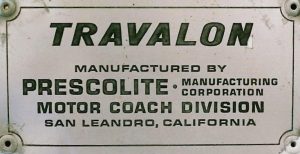
and “ULTRA VAN – OAKLAND, CALIF” badges were installed on the front and rear.
No photos of the interior survive, but the Custom Trim sticker 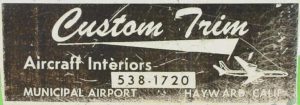
implies an interior similar to #163102.
This is the coach that appears with Jerry Light’s Ultra Van #6 in the July 1964 photo taken at Pumpkin Center SD; we don’t know who the owners were at that time. The coach was registered with the UVMCC from 1985 to 1992 by Edwin & Pauline Wooldridge. The Wooldridges lived full-time in the coach in Seattle WA in 1977, but in 1981 they moved to a property alongside I-5 in Ridgefield WA.
Forrest Gist (#413) visited them there in 1997 and took the last surviving photos of the coach. Though the paint was badly faded by then, the coach was still operational. Unfortunately, in 2001 a grass fire started by teenagers smoking next to the I-5 overpass completely destroyed the coach.
The Eleventh Ultra Van
The Travalon era ended with a flourish. The Prescolite Motor Coach Division had endured through the assassination of the American President in November, but as 1963 faded in the rearview mirror, hubris was about to bite them in the ass.
The final Travalon, serial #264105, was both a clear extension of the design language that had evolved throughout 1963, and a radical new direction.
The new Custom Trim interior

incorporated the Green Machine’s improved bath and more formal dash panel, but instead of the sofa under the picture window it featured #63104’s long “bookcase” cabinet – with an interesting two-section folding table.
Outside, the cockpit window profile and raised kitchen window from #163102 & #163103 made a comeback. And the beltline accent trim and simple two-tone paint scheme from the latter coach did as well, this time with cast Travalon emblems front and rear.
The earlier molded front corner panel concept was taken a large step further, with what appears to be a fully molded one-piece front lower body. The new section extended all the way back to the wheel wells, with a jutting underbite profile that changed the whole look of the coach. Separate round trim rings for the headlights and turn signals were used, and a new fabricated aluminum bumper was faired into the body.
The molded section above the windshield was reshaped (although the interior molded canopy over the front seats didn’t change), and a squared-off rear end with a prominent beltline ridge, new round taillights and rear turn signals, and the same bumper as in front finished out the new look. For the first time, the upper rear corners of the bedroom windows were not camouflaged by rounded sheet metal corners.
Though the wheelbase appears to be unchanged from the 24 footers, the modified body sections result in a 25 1/2 foot long coach. A louvered panel is visible in the right rear corner, probably to provide cooling air for the 102 HP Corvair engine.
Plans were made, deluxe brochure were printed, 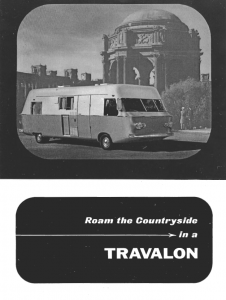
press releases were issued, and the new square body Travalon was unveiled at the 20th annual San Francisco National Sports and Boat Show, January 31 thru February 9, 1964 (at the Cow Palace). Presumably, the brochures were distributed at the show, but the only known surviving copy is the one saved (and scanned) by supervisor Ray Page.
In the days following the Show, the atmosphere around the shop changed. Page remembers “some of the tooling was being destroyed and I believe Dave was having “words” with Jones and Schaffer.” Robert Wollard recalls hearing scuttlebutt that “Dave’s design was a mess and that they had essentially reinvented the whole thing so that soon they would be able to ease him out of the picture and it would be theirs.”
If the new body shape was indeed an attempt to stop paying Peterson’s licensing fees, they hadn’t counted on the fact that Dave was simply never the type of man to accept such a threat without pushing back. In any case, the Prescolite Motor Coach Division ceased operation on February 27, 1964, and the employees were all dismissed.
12 months later (March 1965), the last Travalon was advertised for sale at $9,000 by James Pearson in the Santa Cruz Sentinel, and then again in May in the Sacramento Bee. Another 12 months passed, and the coach (now with 4,000 miles) was listed for sale again by an unnamed individual in the San Francisco Examiner. (May 1966).
The square body Travalon eventually ended up in the hands of a wheelchair-bound Korean war Army veteran and Justice of the Peace in Shelby Montana named James Clinton Farrar. Jamie consulted with Peterson in November 1975, wanting to convert the coach to the side-engine configuration developed for the 600 series coaches in 1971. An odd fire 90-degree Buick V6 engine was installed, along with new windshields and a fresh paint job.
Farrar listed the coach for sale in the 1991 Whales on Wheels newsletter but didn’t find a buyer. Walt Davison #366 visited on one of his cross-country rambles and took the attached color photos. He went back a few years later and found that Farrar had passed away in 1994. He tried to find out what happened to the coach but was told that the engine had been removed and the remainder hauled away to the landfill.
The Twelvth Ultra Van
On that day, 3 weeks after my birth, when Ray Page laid off the Motor Coach Division employees, told them to pick up their final paychecks at Prescolite headquarters in San Leandro, and locked up the old wooden warehouse at 366 8th Avenue for the last time, there was one partially constructed coach left derelict on the shop floor.
But Dave Peterson retained the rights to his design, and his tooling, and his lease; and this remnant of the first failed attempt at production would soon become a springboard for Dave’s new vision. He wasted little time rebooting his dream, placing a new advertisement in the June 1964 issue of Family Motor Coaching magazine, and restarting production.
The twelfth Ultra Van was the last 24-foot-long coach built in Oakland. In most ways it was a throwback to the coaches that preceded Prescolite’s innovations, with built-up front body corners, split Chevy Pickup bumpers, Ford Econoline headlights, 13 inch ornamental dually wheels, and a 1963 Corvair drivetrain with 102 horsepower engine.
The front slider window profile was returned to the original position below the beltline, but the sheet metal camouflaging the upper corners of the bedroom windows was gone for good. The kitchen window was lowered back down to the beltline as well, although this would change once again a few years later.
Two major innovations were introduced that would set the standard for the next seven years. A new taillight configuration was developed with large round fixtures faired vertically into the rear corners, using Trail-Lite/Bargman no. 98 “wedding cake” lenses. And a new serial numbering scheme was introduced, starting with #201.
Ultra Van #201 passed through its first three owners rather quickly. It was originally sold in 1964 to Courtney Q. Nelson of Chattanooga TN. He sold to Lloyd L. Hamilton of Miami Springs FL, who bought #456 new in February 1969 and subsequently listed #201 in the 4/21/69 Miami Herald at $5,900. James I. Minix of Homestead FL was the third owner, selling to Albert Austin of Brookville FL for $2,500.
Albert & his wife Elinor owned the coach for at least twenty years, 1973-1993 – though it wasn’t until 1977 that they joined the UVMCC. Eventually Albert passed away and Elinor listed the coach in the 9/19/92 Tampa Bay Times for $3,000. Bob & Rachelle Ennis of Soddy-Daisy TN became the fifth owners in 1994, selling to the current owners Jim & Ann Guider of Chattanooga TN in 1996.
Jim & Ann have since moved to Rossville GA, replaced the tired 102 hp engine with a refreshed 110 hp engine, and gradually stripped the faded and chalky paint from the coach. They often use the coach in parades and as a support vehicle for their local Corvair club.
Note: Top photo from 1967 courtesy of John and Kathy Acosta.
The Thirteenth Ultra Van
The thirteenth Ultra Van was built in late 1964 for William & Grace Lane of Pico Rivera, CA. Assigned serial #202, this coach is both transitional and utterly unique.
Previous coaches had a diagonal side frame that followed the windshield shape and established the rear edge of the front corner panel. With #202 Peterson shortened the forward body, truncated the diagonal frame, and developed a new fiberglass corner panel that wrapped back to the vertical frame at the front of the wheel well. This resulted in the first 22-foot-long coach, with its distinctive narrow slider window shape.
#202 was also the first to use ethafoam bumpers cemented directly to the body, with the now-standard Bargman “wedding cake” taillights installed above the rear bumper and small backup lights installed below. Like #201, the taillights were mounted lower than what would eventually become standard with coaches after #206. This was the last coach with the front turn signals mounted inside the Ford Econoline headlight bezels.
Removable holding tanks were installed beneath the floor, made of riveted aluminum, and lined with sealant to prevent leaks. The 1964 “camber compensator” rear suspension was used, with the new 110 hp engine and 13″ ornamental dually wheels. Weighing in at 2,875 lbs. (with 5 gallons of gas), #202 was also an exceptionally light weight coach and acceleration with the stroked-out engine was brisk.
A unique new configuration was developed at the Lanes’ request, with the galley installed directly behind the passenger seat and the entry door moved rearward. A slightly taller refrigerator was used, with the usual drawer above it reduced to a sliding counter extension.
The galley was arranged with the stove on the left (next to the passenger seat) and the refrigerator on the right (next to the entry door). Note that the stove had also been installed to the left in #101, #200, #103, #63104, and #201, but was on the right in #104, #163102 and #264105.
The usual molded fiberglass canopy above the front seats was omitted, but upper cabinets were built into both sides of the cockpit. The front wheel well on the driver side received an extension to support the bench seat, but the passenger side did not. A wall furnace was installed on the front bathroom wall next to the entry door.
William and Grace became charter members of the UVMCC in 1967, having moved to Baldwin Park. They registered their coach with the Club as #13, moved to Pacoima in 1970, and let their membership expire after 1971. The sealant lining the inside of the fuel tank started crumbling and clogging the carburetors, and William wasn’t able to resolve the issue.
He parked the coach with about 37,500 miles on the odometer, then in February 1987 Jim Craig bypassed the fuel tank with a 5-gallon gas can and drove it home to San Diego with no further problems. Jim and Marlene put another 12,500 miles on the coach in under 2 years, and after moving to Joshua Tree in 1988 they offered the coach for sale at $6,995, later reduced to $5,495.
Donald Gilbert of Midland TX bought the coach in December 1988, offering it for sale again at $5,250 in 1990, although by mid-1991 the asking price had been reduced to $3,500. Richard K. Morrison of La Luz NM owned the coach next, and although he let his Club membership expire in 1996, the coach remained in his family until Ken Morrison of Fort Collins CO sold it in 2011.
By this time, the driver side seat pedestal extension appears to have been removed, the unique dual bullet-style front turn signals replaced, and a steel tube front bumper and towbar arrangement installed. The coach was damaged during the delivery to the San Antonio TX buyer, and its current condition, location, and owner is unknown.
The Fourteenth Ultra Van
Ultra Van #203 is the last of the first generation of Ultra Vans – with the extended A-pillar member that defines the front corner of the coach, the chrome Chevy pickup bumpers, the swing-arm rear suspension, and the ornamental dually wheels. It is also the last coach with the stove installed on the left side of the galley.
At 22 or 23 feet long, #203 first appears to be a dead ringer for #6, until you start to notice the details: the squared-off rear window corners, the wedding-cake taillights, the lack of tow hitches and cooling air intakes, and the distinctive front wheel arches.
This is the first Ultra Van where the Ford Econoline headlight bezels were not modified to incorporate the turn signals – instead, the turn signals are mounted in the body just below the headlights. This is also the only coach (other than the prototype) where the fiberglass front roof corners are separated by an aluminum section with support ribs underneath.
Even though #203 was built in Oakland, it has anachronistic “Ultra Van – Hutchinson, Kans”  emblems installed front and back. It is currently registered as a 1965 model.
emblems installed front and back. It is currently registered as a 1965 model.
Dave Peterson’s notes tell us that the fourteenth Ultra Van was initially delivered to Robert V. McAninch of Jupiter Auto Sales (Jupiter FL) in. Huston & Maida Hurt of Redding CA registered coach #203 with the UVMCC from 1968 to 1973, and Richard & Retta Kossow registered it with the Club from 1988-2002. Retta served as juror on the trial of the four policemen accused of using excessive force against Rodney King in 1992. Richard passed away in 2001.
Michael LaRoche of Ventura CA bought the coach in 2005 and found that it had not had a valid registration “since the early eighties”. In 2008, he sold the coach for $200 to the current owner Aaron Landy of Los Angeles CA. Aaron joined the Club from 2009-2012.
Aaron had to replace the blown/warped 140 hp engine with a rebuilt 110 hp engine to get the coach back on the road. Over the years he has also made structural repairs, replaced the windshields, fixed several issues with the steering, and thoroughly insulated the coach with polyisocyanurate board (secured with expanding foam gap filler and reflectix tape).
The coach lives on the street in west Los Angeles, and random strangers wandering past frequently post pictures of it on Instagram.
The Fifteenth Ultra Van
Records of the 1965 Oakland Ultra Vans (serial #203-210) are even more jumbled than the Travalon records:
–Dave Peterson’s customer records show three owners of #15 and one of #204 (which should be the same coach).
–When Jim Craig bought #206 he found out it was the same coach that Pete Dodge had listed as #65 (similar to when Jim bought William Lane’s #13 and found out it was actually serial #202).
–Customer records show one owner of #18 and two of #207 (and both numbers were listed with different owners in the 1969 roster).
–Vernon Sandel listed his 27 foot long coach as #108 for 4 years and then 208, 108, 208 for the next three (it does not have a 1st generation front end so it can’t be #108).
–Hurd’s #20 (serial #209) is not the same vehicle as Darwin’s #209 (though both had leading-arm rear suspension).
In addition, almost all of these coaches have disappeared with hardly a trace.
#15/204 hasn’t been identified since 1973.
#17/65/206 was stolen sometime between 2001 and 2011, and never recovered.
#18/207 hasn’t been identified since 1973.
#19/208 (the 27 footer) was last seen in 2007 near the Salton Sea.
#209 hasn’t been identified since around 2000 (but #20 was at the 2019 Ultra Week in Kearney).
#210 was last seen in a Santa Ana CA used car lot in the mid-1980s.
As a result, the only confirmed information we have for #15/204 is the names of five owners:
#15 was delivered to Judge Charles Bruce of Atlanta GA.
#15 was owned by C. M. “Mel” Winter of Winter Welding and Machine Corp in York PA.
#15 was owned in 1969 by John H. Jr. & Carmen F. Morris of Palm Springs CA (who joined the UVMCC for one year).
#15 was bought from Morris by Leon G. Paquett of Seattle WA.
#204 was owned by Frank Cheney of Waldorf MD sometime prior to 6/19/73.
When Mel Winter met Norm Helmkay at the famous Hershey swap meet, Mel said he had owned the only 26 foot long Ultra Van, but we don’t know if he meant #15/204 was stretched, or if he also owned #19/208 (the 27 footer) at some point, or if there is some other explanation. For whatever it is worth, Dave Peterson never mentioned building any other stretched Ultra Van besides #208, so it seems unlikely that #204 was 26 feet long.
In Christy Barden’s 1992 “First 24 Ultra Vans” article, he states that #204 was a 22 foot coach with a modified late model Corvair suspension. The source of that information is not recorded.
Another possibility to consider is whether Victor “Jack” & Ethel Darwin of Carlsbad CA could have misidentified their coach #209 when they joined the Club in 1972. It isn’t hard to imagine the DMV transposing the serial number 204 into 209…
The Sixteenth Ultra Van
Chevrolet made rapid and extensive upgrades to the Corvair platform between 1960 and 1965, and Dave Peterson eagerly incorporated these developments into his Ultra Vans.
For example, starting with the original engines of 1960 (140 cubic inch displacement), Chevrolet increased cylinder/piston diameter in 1961 (to 144.7 c.i.d.), and piston/crankshaft stroke in 1964 (to 163.7 c.i.d.). The initial 80 hp engines evolved into a dozen different configurations, and in particular the 102 hp (1962), 110 hp (1964), and 140 hp (1965) engines found their way into Ultra Vans as soon as they became available.
Improvements to the Corvair rear suspension were likewise quickly adopted into the vans. The initial “swing arm” configuration had been a simple, robust, and relatively inexpensive arrangement, commonly used in many small rear engine vehicles (Corvair, Volkswagen, Renault) – but it had drawbacks. And although the addition of a transverse leaf spring “camber compensator” in 1964 effectively nullified Ralph Nader’s criticisms, Chevrolet wasn’t resting on its laurels.
For 1965, Chevrolet introduced a sophisticated new rear suspension featuring trailing link control arms stabilized by lower strut rods and by the driveshafts themselves. Peterson found that the new arrangement allowed him to move the drive wheels outboard for the coaches by simply relocating the control arms and lengthening the driveshafts and strut rods – thereby eliminating the need for the ornamental dually wheels.
According to Christy Barden’s 1992 newsletter article “The First 24 Ultra Vans”, Peterson told him that coach #11/109 (we don’t know what this refers to, possibly one of the Travalons being used as a testbed) received a “leading arm (links) suspension later upgraded to trailing arm,” and that #204 received a “modified late model suspension.” But since neither of these coaches has been identified in the last 40 years it is hard to say how closely they resemble the arrangement installed on #205, #206, #209, #20, and #211. For these coaches, Peterson decided to install Chevrolet’s new suspension backwards – creating a “leading arm” suspension. Nobody knows why.
Ultra Van #205 is a fairly typical example of the early 2nd generation Ultra Van. The turn signals are installed between the Econoline headlights and the surface mounted bumpers, the rear windows are squared off, there is no tow hitch. The wedding cake taillights are still mounted in the lower position, but the galley has now been rearranged with the stove on the right. An engine cooling air vent has been installed on the right side, and a large rectangular hatch installed underneath the windshield (possibly a generator compartment to support the roof air conditioner), but we don’t know if these are original equipment or owner modifications.
Up front, the Ultra Van emblem is long gone, replaced by a club-sponsored “UltraCoach” emblem – the legacy of a time when a club dominated by older and mostly retired couples wanted desperately to disassociate themselves from the “let it all hang out” custom vanning craze of the 1970s.
Ultra Van #205 was initially delivered in 1965 to J. A. Wales Jr. of Wolfeboro NH, who paid over $9,200 for the coach. He didn’t have it long though, advertising it for sale at $6,995 in the May 1966 Family Motor Coaching magazine. By May of 1967, the coach had 14,000 miles on it and the second owner Larry Selig of Albany NY was advertising it for sale in the same magazine (he wanted something bigger). Richard E. Warman of Danvers MA is the next owner listed in the customer records, followed by Mort Bryant of Atlanta GA. Mort sold the coach to Grant and Meta Brown in December 1972, who registered the coach with the UVMCC in 1973.
The next owners were Elbert & Margaret Carpenter of Camp Pendleton CA, who registered with the club in 1976; followed by Milo & Viola Webber of San Fernando CA in 1977. Sid & Bunny Chilcott of Carlsbad CA joined the Club in April 1980, then Ernest & Rose Perlich of Tarzana CA in August 1981, then Paul & Rose Schoenfeld of Marathon FL in July 1983. Finally, a CHP officer named Gary Ligget (or Legget) sold the coach to Gary S. Stern of Topanga CA, who joined the Club in February 1987. Gary has owned the coach ever since – making him by far the longest owner of record for the coach.
Gary is a musician and music producer who (among his other credits) once ran The Silvery Moon Studios in West Hollywood. Gary’s Ultra Van currently serves as his home base and practice studio.
The coach shows up in the background at :21 and 2:46 in this Honda Z600 recovery video from 2013: https://youtu.be/X0De7ruhTXM
The Seventeenth Ultra Van
In August 1965, Dave Peterson reached an agreement to license Ultra Van production to Jack Tillotson of Kansas City. Tillotson was a magazine publishing magnate, so one of the first things he started planning was the printed promotional material. And the first thing he needed for that was a model for his color brochure.
The seventeenth Ultra Van had recently rolled out of Peterson’s Oakland shop, featuring all the latest upgrades – including the distinctive new double stripe trim scheme and the relocated taillights (in a higher position than on previous coaches). The proud new owners were amenable to lending their acquisition to the proceedings, and the resulting images would be used in magazine articles, advertisements, and four different versions of the color brochure (1965-36 pgs., 1966-36 pgs., 1968-24 pgs., and 1970-24 pgs.).
Ironically, these iconic photos depict a coach with several prominent features that were never found on any coach produced by Tillotson’s operation: Ford Econoline headlight bezels, 13″ wheels with turbine wheel covers, a windowless entry door, and no coffee bar below the windshield. The leading-arm rear suspension was of course less prominent, but no less incongruous.
There are also a few features worth pointing out in the interior: In the bedroom, the cabinet above the rear hatch was omitted – giving the area a uniquely sleek and roomy appearance.
In the galley, the upper cabinet has sliding, not hinged doors (common in early factory coaches); and the smaller refrigerator and deeper drawer above it become more obvious with the stove on the right.
In the cockpit, notice the three binnacle instruments mounted above the windshield, the pictures mounted to the upper cabinet doors, and how the windshield drapery rod extends well beyond the upper canopy.
This coach was built for Irving C. (Pete) & Edna Dodge of Temple City CA. Pete & Edna were founding members in 1967 of the Ultra Van Motor Coach Clubs, Inc., registering their coach as #65. They were active in the club until 1972. Eventually #65 passed into the hands of Scott & Eva Johnson of Boulevard CA, who joined the Club from 1976-1977.
Noel & Elaine Koller of Bonita CA attended their first Club Rally in January 1979, at Frontier Town in El Cajon CA. They registered with the Club as owners of Ultra Van #206 in 1979, offered it for sale in several 1984 newsletters, switched to #210 in 1985-1987, and remained associate members of the Club from 1988-1996.
Because of the registration number switch, when Jim & Marlene Craig of San Diego CA (already owners of #232) bought the coach with no engine in November 1984, they were unaware that they were buying Pete Dodge’s old #65 – until they recognized the pictures on the upper cockpit cabinet doors and the binnacle instruments. In December 1986 they sold #232 to focus on restoring #206. Jim installed a new engine and test drove the coach, but in February 1987 they acquired #202 (the Thirteenth Ultra Van above), and in May 1988 they moved to Joshua Tree CA – leaving #206 behind in the care of Jack Martin of Chula Vista.
Jack doesn’t seem to have ever finished the restoration, because as late as 1992 it was still inoperative, parked beside his house. Royce Hildreth of the San Diego Corvair Club remembers seeing it there in 2001-2002. Jack moved to Texas around 2003-2004, again leaving #206 behind. We don’t know the names of the last owners, but Jim Craig reports that he heard it was stolen from them and never recovered.
The Eighteenth Ultra Van
Another lost coach, almost everything that we know about #207 is what is found in the customer records:
#18 was built for Lee C. McDonald of Vallejo CA.
#18 was registered with the Club by George & Effie Seay of Arleta CA from 1968-1971.*
#207 was registered with the Club by William J. & Ida L. Miller of Stockton CA in 1969.
#207 was owned by C. J. Olsen of Escondido CA sometime prior to 6/19/73.
*Notice the ownership overlap between Seay and Miller. One possible explanation is that the Seays sold the coach after 1968 but maintained their membership in the Club until 1971.
Because of an article in the March 1969 Trailer Life, we also know that George & Effie Seay attended the Lake Elsinore Military Academy rally in September 1968. Slides from this rally were previously shown above with the Fifteenth Ultra Van
The Ninteenth Ultra Van
The nineteenth Ultra Van was the longest Ultra Van ever, at 27 feet. It was specially built in 1965, purportedly for a man that had a wife and a girlfriend that all wanted to travel together. Their plan doesn’t seem to have worked out very well though, because the coach was offered for resale the following summer, with an asking price of $9,950.
Other than the stretch, #208 appears to have all the hallmarks of a typical 2nd generation coach – vertical front corner panels, narrow front windows, squared off rear windows, ethafoam bumpers, wedding cake taillights (in the raised position), and double stripe paint scheme. The entry door is equipped with a small square window, which became standard equipment from here until sometime in 1967. It also had 13-inch wheels and turbine wheel covers – just like all other 1961-65 coaches (although swing-arm suspensions used 4 bolt wheels and leading arm suspensions used 5 bolt wheels).
The extra five feet of length appears to be added entirely between the wheels, with the entry door, galley window, and picture window moved about a foot to the rear of the usual location. The exterior venting and access panels show that the stove is on the right, the on-demand water heater is in the usual location immediately ahead of the bedroom window, and the furnace is in an intermediate position. No photos survive to help us visualize the undoubtedly unique interior layout.
The original owner was Eleanor Younger of Oakland CA, followed by Vernon & Ilabelle Sandel of Glendale CA. The Sandels were a family of five that wanted a coach to use for traveling in Mexico. They were founding members of the UVMCC in 1967, identifying their coach as #108 until 1970, and as #208 thereafter. They dropped out of the Club in 1973 when Vernon passed away. No later owners are known to the Club.
In 1967-68, Sandel’s van had a motor scooter on a rack below the windshield, a TV antenna dome on the roof, and a spare tire mounted on the roof above the rear window. By 1971 an extra pair of turn signals had been added to the front, and the motor scooter rack removed, but the spare tire was still on the rear roof. Later the spare was moved to the front of the coach.
Surviving photos show the stretch coach outside the factory in Oakland CA (1965), at the Knotts Berry Farm rally in Buena Park CA (1967), at the Santa Cruz county fairgrounds rally in Watsonville CA (1968), at a service visit to the factory in Hutchinson KS (1968), at the Lion Country Safari rally in Irvine CA (1971), and at an RV park near the Salton Sea in CA (2007).
The Twentieth Ultra Van
Although the official registration papers show serial #209, the twentieth Ultra Van has always been identified publicly as #20. The coach has been heavily modified over the years, but still retains the hallmarks of an early 2nd generation coach (with the stove on the right and raised taillights).
#20 was built in 1965 for Myron & Lorena Hurd of Bell Gardens CA, who were Club members from 1968-1978. Sonny (V.H.) and Becky Harben of Princeton Fl were the second owners, registering #20 with the Club from 1979 to 1982. They enjoyed several trips in the 15-year-old coach but parking it in an avocado grove did no favors to the original double-stripe paint scheme, so when they finally sold it on it was in rough shape.
The third owners of #20 were Pat (John) and Margie Fitzgerald of Englewood FL, who joined the Club in January 1983. With help from his brother Chance, Pat restored and modified the coach extensively.
They replaced the rear window and trunk with a full-length windowless hatch, rebuilt the entry door with an extra-large window (and late-model piano-style hinge), constructed a custom screen door, installed a pair of fresh air vents up front, added rain deflectors over the front and rear windows, replaced the driver’s side mirror with a 1973-79 Ford pickup mirror, and gave the coach a racy new two-tone paint scheme – cream overall with a chocolate brown window band and tricolor (red-orange-yellow) beltline stripes.
In 1986 Pat and Margie acquired Ultra Van #448, and sold #20 to Roy & Geraldine Neal of Ballston Spa NY. The Neals maintained their Club membership from 1986 until 2006, but they sold the coach in 2004 to Chuck Fetter of Galway NY. With a twenty year old paint job on a forty year old coach, and significant body damage in the right rear corner to repair, Chuck set his sights on a complete rebuild.
Chuck completely gutted the coach, stripped the old paint, repaired the crushed rear corner, had the engine and transmission rebuilt, constructed a new fuel tank, and replaced the water & waste tanks with large plastic tanks (adding aluminum bracing to support the floors).
A completely scratch-built interior for #20 was created, with all new wiring, insulation, plumbing, cabinets, flooring, and upholstery. Chuck retained the original loose bench seats but omitted the refrigerator and furnace – choosing instead to use a picnic cooler and a space heater. He relocated the windshield wipers, converted to disk brakes in front, added a trailer hitch in the rear, and modified the leading-arm rear suspension by reversing it and adding side braces (while retaining the lower strut rods and fixed-length driveshafts).
Upholstery in shades of brown nicely complements the new cherry paneling, and miniblinds and vinyl flooring are used instead of curtains and carpeting. The floorplan is conventional, but the full-width aluminum dashboard is completely unique, featuring a custom instrument panel with all new gauges and a “Marvin the Martian” ray gun shifter.
Chuck painted the coach a striking metallic silver overall and installed new windshields, new driving mirrors on both sides, and a roof air conditioner. He added identification lights (the triple light clusters above the windshield and above the hatch), a porch light, and underbody lights; and modified the “wedding cake” taillights to use 1959 Buick “stinger” lenses.
To complete the new look, he added reproduction “ULTRAVAN – OAKLAND, CALIF” emblems, whitewall tires, baby-moon hubcaps, and personalized “FRM MARS” license plates.
Chuck joined the Club for 2005-2006, completed the restoration in late 2011, and proceeded to enjoy many regional car shows and tailgate parties with the coach. But all good things come to an end and in early 2019 he sold the coach to Corvair guru Jeff Stonesifer of Gettysburg PA (proprietor of the famous Corvair Ranch).
Jeff had a mission in mind for his new acquisition, so he performed a complete mechanical inspection, repaired the traces of nearly ten years of wear, fabricated a custom towbar, added an exterior shower, and installed 1980 Z-28 Camaro wheels.
By August 8th, the coach was ready for the Military Vehicle Preservation Association (MPVA) Convention, afterward joining the Lincoln Highway Association (LHA) Centennial Tour commemorating the one hundredth anniversary of the First Transcontinental Motor Convoy.
Jeff and his daughter Abigail followed the Centennial Tour west from York PA to Carson City NV, turning back just in time to return to Kearney NV for the 2019 Ultra Week rally. They had some overheating concerns with the 140 hp Corvair engine in NV and judged it wiser to complete the trip east under tow behind a rented U-Haul box van.
Photos from the 2018 Ultra Week rally in Kearney NE can be seen here:
https://ultravan.org/2019-national-rally-gallery
Dedicated albums of Jeff and Abigail’s transcontinental journey can be seen here:
https://www.instagram.com/ultralincolnhighway
And here:
https://www.facebook.com/ultralincolnhighway
Many photos of the LHA 2019 Military Convoy Centennial Tour can be seen here:
The Other Twentieth Ultra Van
Today’s Ultra Van is an anomaly that doesn’t fit the sequence. It is either an extra coach, unmentioned in any of Dave Peterson’s notes, or one of several Oakland-built Ultra Vans whose identification shifted over the years.
Victor “Jack” and Ethel Darwin of Carlsbad CA were members of the UVMCC from 1972 to 1986, registered as owners of a coach that they identified as Ultra Van #209. Ethel rejoined the Club from 1989 to 1993, registering as former owner of #209. During the interim, Jack had passed away (1988) and the coach had been sold. Ethel herself passed away in 1993. Dean Coshow of Valley Center CA is listed in the Registry as the last known owner of the coach, but he never joined the Club and appears to have also passed away in 1993.
Pictures of Darwin’s #209 survive in the Ryerson slide collection, showing the coach at the January 1974 rally in Hemet CA and the April 1976 rally at Lake Cahuilla CA. Rally reports also state that the Darwins attended the first ever UVMCC national rally at Henderson AR in October 1973.
The pictures reveal a 2nd generation coach incorporating Econoline headlights with separate turn signals, galley configured with the stove on the left, and taillights in the raised position. By 1974 it featured a unique two-tone paint job (cream over chocolate) and bumpers fabricated from welded irrigation pipe. By 1976 a Coleman rooftop air conditioner and an awning rail had been installed. Walt Davison visited the Darwin’s during his wanderings, and later stated that their coach had the “leading arm” rear suspension (Walt passed away in 2016).
The 2nd generation body style and leading arm suspension indicate that Darwin’s Ultra Van #209 must have been built in Oakland in 1965, but it is definitely not the same coach as Myron Hurd’s Ultra Van #20 (serial #209); and it also could not be a mis-identified #201, #202, #203, #205, #206, #208, or #211. Records of both #204 and #207 cease at roughly the same time frame as Darwin’s #209 appears, and records of #210 are even more sparse – but until one of these coaches reappears it remains impossible to state conclusively how the puzzle fits together.
The Twenty-First Ultra Van
The last Corvair-powered Ultra Van to be completed in Oakland is yet another cipher, about which we know very little.
Dave Peterson’s customer list shows that #210 was delivered to Jim Carini of Oakland in October of 1965 (two months after the agreement to transfer production to Kansas had been signed). Noel & Elaine Koller of Bonita CA changed their Club membership from #206 to #210 in 1985 (for one year only). And Floyd & Joyce Sickenberger of Keystone Heights FL changed their Club membership from #473 to #210 in 1987 (again for just the one year).
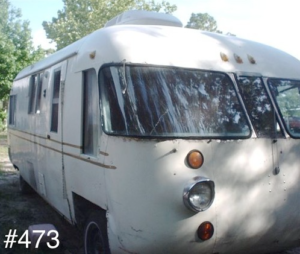
Christy Barden’s “First 24 Ultra Vans” article in the Fall 1992 Whales on Wheels newsletter shows that #210 was a 22 foot long coach that was later converted to use a Dodge engine and chassis. Jim Craig stated in 2011 that Noel Koller had a coach with a steel truck frame under it that he remembers seeing in a RV sales lot in Santa Ana CA in the mid-1980s.
Pictures of the January 1979 Frontier Town rally show two Oakland coaches; the first appears to be #205. Since Noel & Elaine Koller attended that rally it is possible that the other could be their #206 (if they had added a front-mounted spare tire, a large driver side mirror, and a blue stripe) or their #210 (if they owned it six years prior to registering it with the Club).
The Twenty-Second Ultra Van
In late 1965, Ultra Van #211 was the last Corvair Ultra Van to drive away from the wooden warehouse at 366 8th Avenue in Oakland. It was also the last Ultra Van with the Ford Econoline headlights, the small (corner) dashboard,
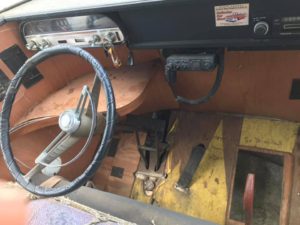
and the leading-arm rear suspension.
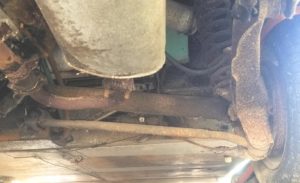
It had wedding cake taillights in the upper location, a small window in the entry door, stove on the right, ethafoam bumpers, double-stripe paint scheme, and a 140 hp Corvair engine. It was the first coach equipped with ULTRAVAN – HUTCHINSON, KANS emblems
 and 14″ wheels, though these were probably added in 1966.
and 14″ wheels, though these were probably added in 1966.
#211 was built up to a drivable stage (no interior installed), then it was loaded with jigs, patterns, and molds, and driven to Kansas by Roger C. Fletcher (Ultra, Inc. Production Manager and employee #002) to support the setup of the new Ultra, Inc. factory in Hutchinson. The Hutchinson News reported in January 1966 that “Peterson and Fletcher practically are living at the plant, cooking meals and sleeping in their Ultra Vans until they can get permanently established.” The paper also reported that this coach was almost complete by March 3 1966, and a later article reported a completion/delivery on May 26 1966 that was likely this coach.
Retired publishing magnate John E. Tillotson senior (known around the Ultra, Inc. factory as Mr. T) was reported to be the original owner of #211, but it seems that the coach was actually operated as a factory demonstrator until the end of 1966. Mr. T displayed the new coach at the third annual Family Motor Coaching Association (FMCA) convention in Glenwood MN, (July 8-10, 1966) and the sixth annual National Campers and Hikers Association (NCHA, now known as FCRV) campvention at Lake Kanopolis KS (July 11-15, 1966). Mr. T passed away in 1999, his wife Clara in 1991.
The first private owners of #211 were Mr. & Mrs. H.O. Dickert of Wausau WI, who took delivery around January 10 1967 – but by August of 1967 they had sold the coach to Mr. & Mrs. Arthur A. Ludtke of Rhinelander WI. The next recorded owners are Chance & Margaret Fitzgerald of Mendota IL and Talladega AL, who acquired the coach after it sat in a Wisconsin cornfield for 11 years.
Chance & Margaret joined the UVMCC in 1972 and remained members until they passed away – Margaret in 1993 and Chance in 2005. They never registered #211 with the Club however – they were registered with #456 from 1972-1979 (when it was destroyed in a fire),
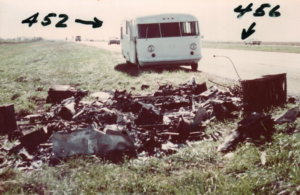
#368 from 1981-1984 (although that coach was reported as destroyed in a fire in 1968), and #286 from 1985-1997. Chance was an extraordinarily adept sheet metal fabricator, though he doesn’t seem to have made any of his signature modifications to #211.
Walt and Marilyn Davison of Coral Gables FL and Sylacauga AL (better known as owners of #371, #452, & #366) bought #211 from Chance and resold it to William J. “Bill” & Patty Welle of Nokomis FL. Bill & Patty were the first owners to register the coach with the Club (1991-1995), and Bill wrote several articles for the newsletter on his experiences with the coach (notably “How I painted my Ultra Van for $100” and “Love and Hate“). Bill (partially) converted the 140 hp Corvair engine to 110 hp by the simple expedient of replacing the heads and discarding the secondary carburetors.
The next owners were Kay Armstrong and Tony Foresta of Orlando FL, who joined the Club for only 1998. Russ Rinta and Roberta Elftman of Hernando FL had the coach from 2002-2009 (joining the Club for 2003-2004). They successfully drove the coach to their new home in Fayetteville TN, but weren’t able to keep it running beyond that, and eventually listed it on eBay. Fred & Sue Marsh of Painted Post NY registered with the Club for 2010-2011, and the coach spent most of 2009-2020 parked beside “Friendly Fred’s” auto repair shop on Addison road.
Current owners Tom & Erin Koprevich of Grand Island NY bought the coach from Fred on August 12, 2020, and immediately dove into the process of a long overdue complete mechanical restoration. Starting with pulling the engine and gutting the interior, they have already completely refurbished the engine, suspension, brakes, carburetors, and LPG tank; reinforced the front end and added towbar brackets; upgraded the brake master cylinder, alternator, and front engine mount; and converted the 140 distributor to 110 specs. The new engine features a replacement block, an FC cam, and 110 heads which Tom himself heavily upgraded.
Tom & Erin are planning to install a high end interior with all-new wiring, and replace the rear window with an Airstream unit.


